
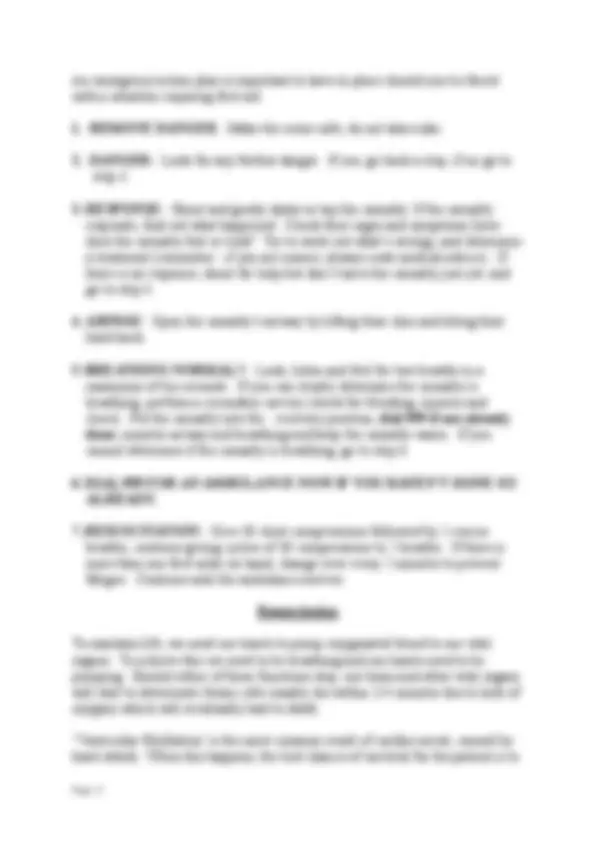
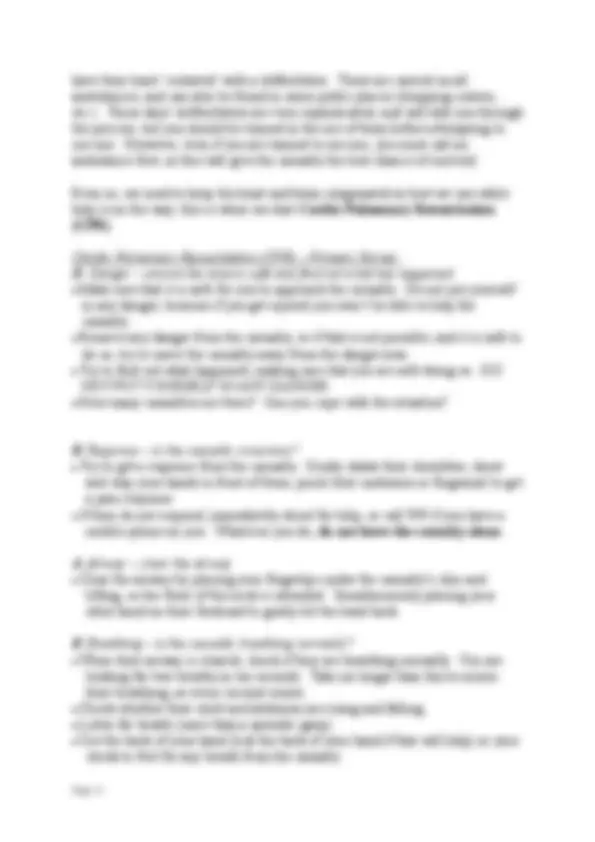
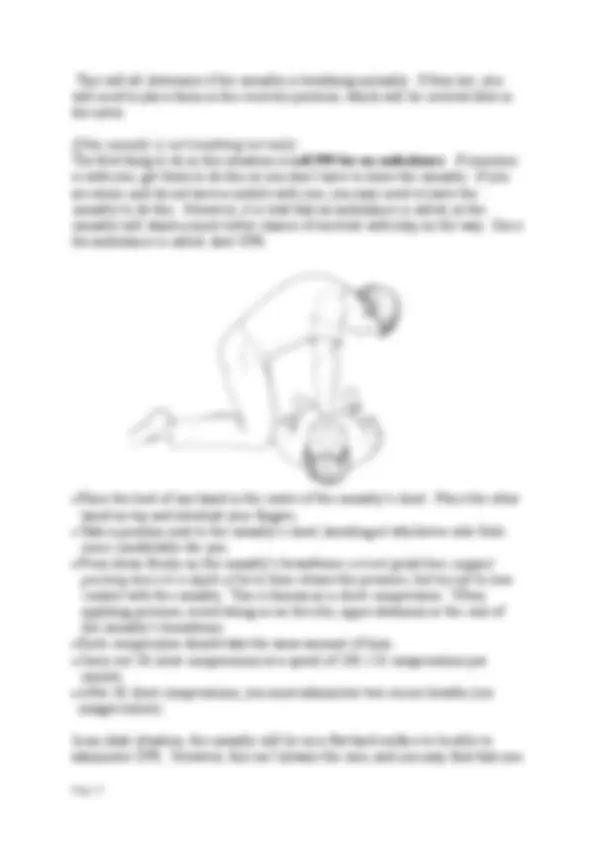
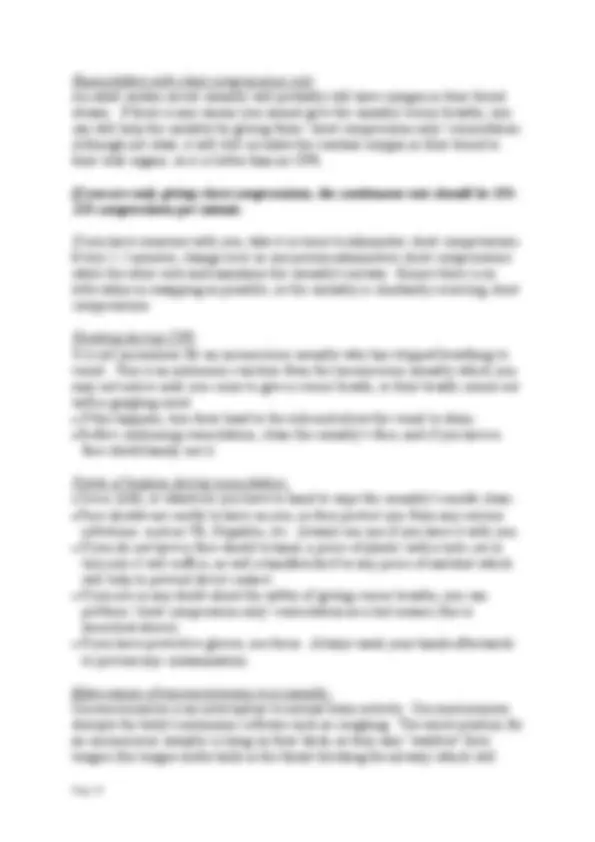
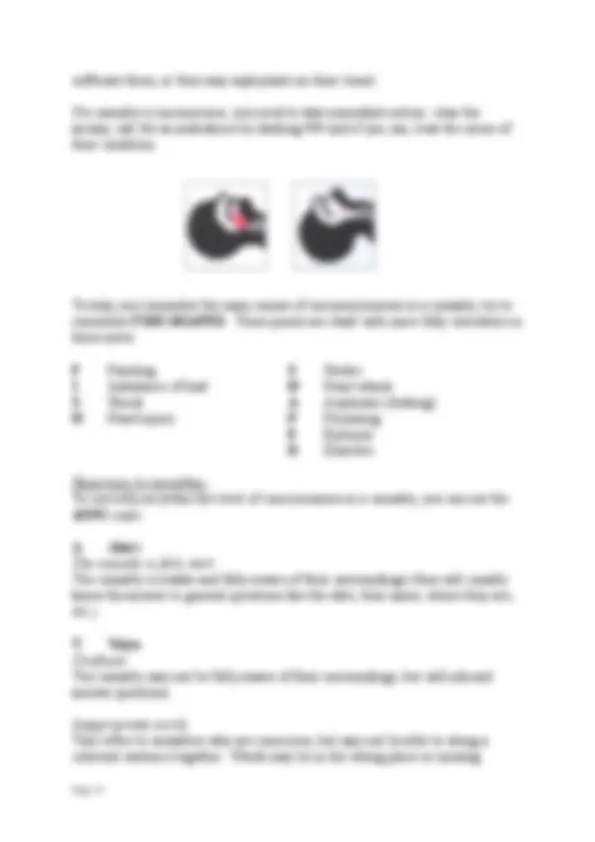
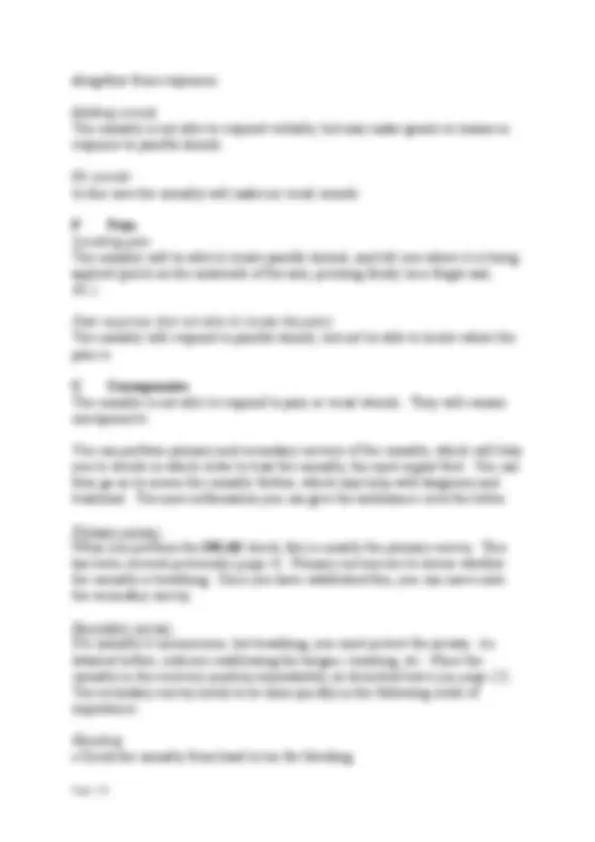
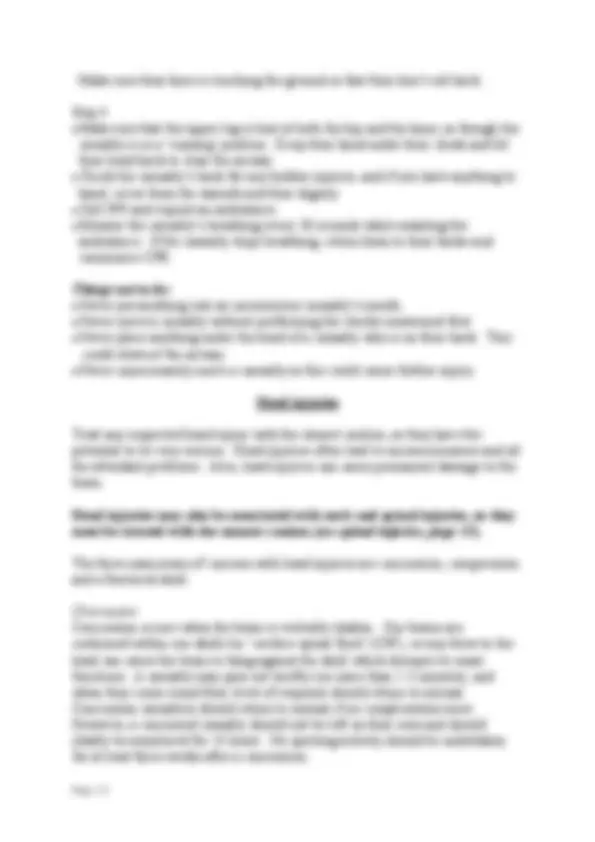
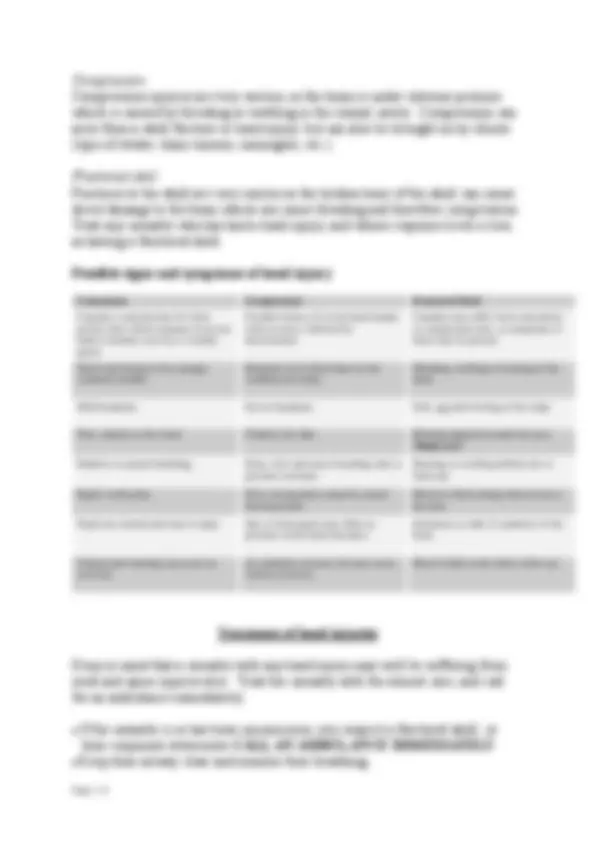
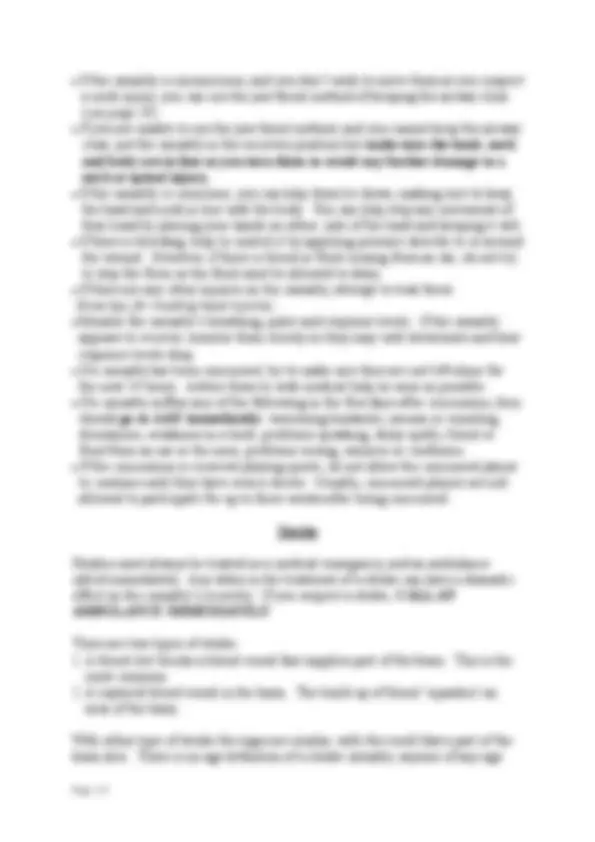
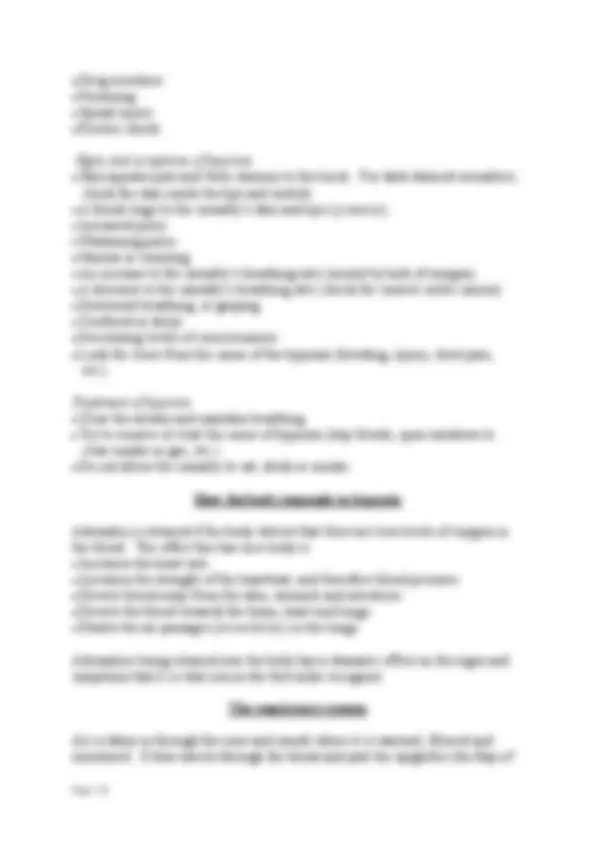
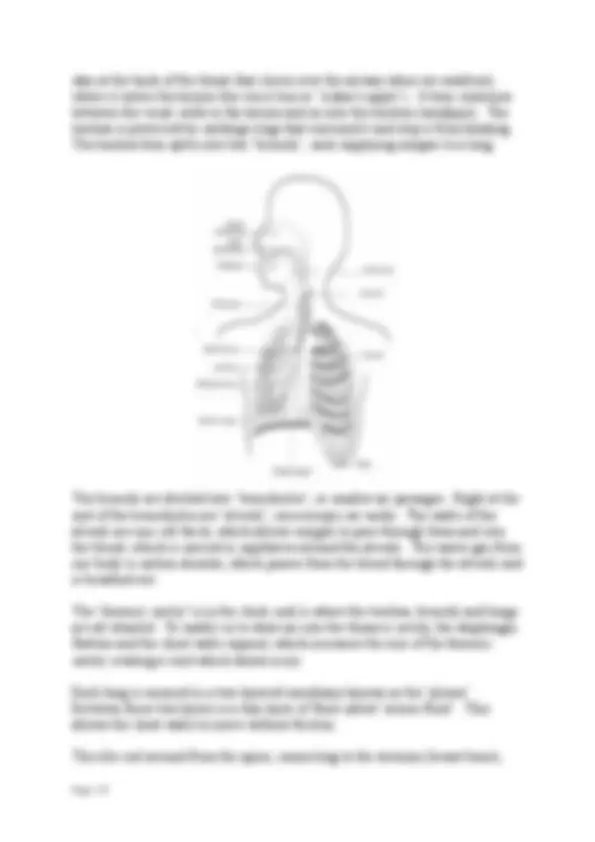
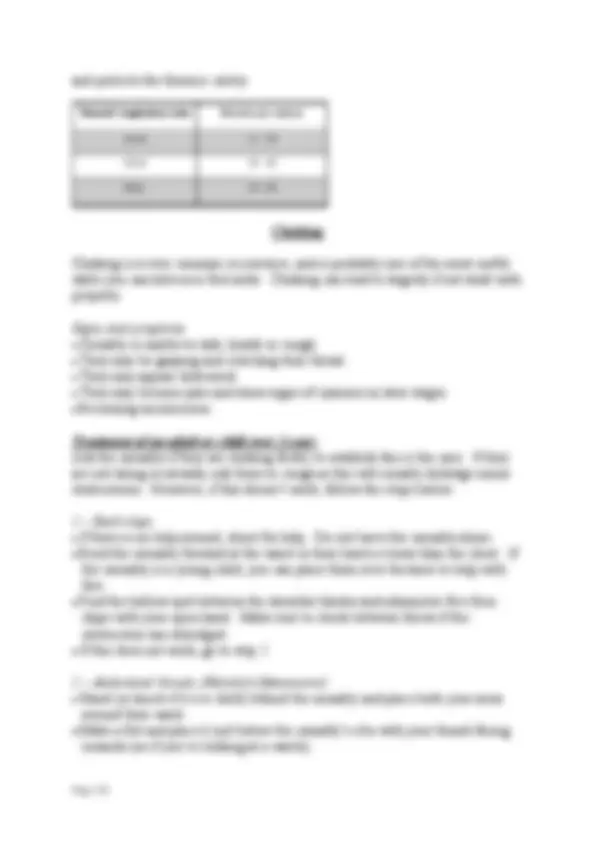
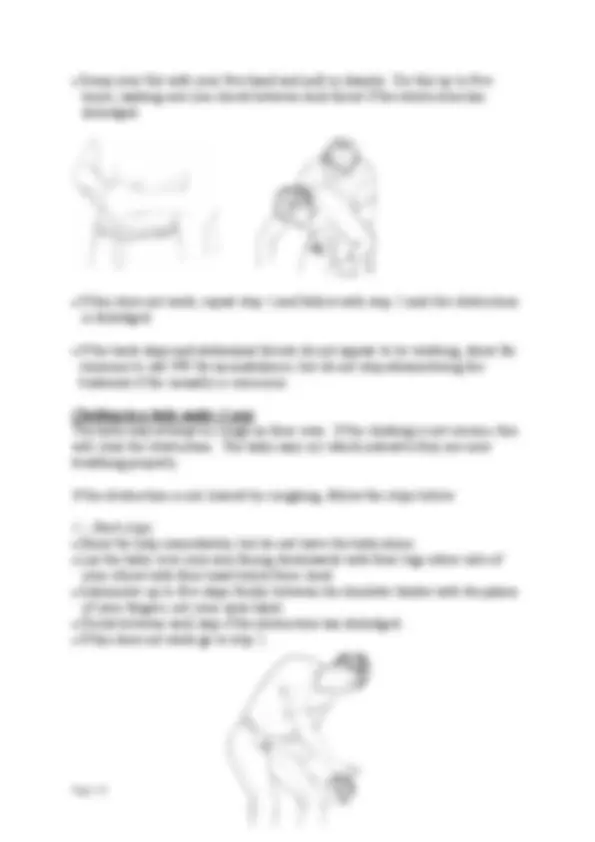
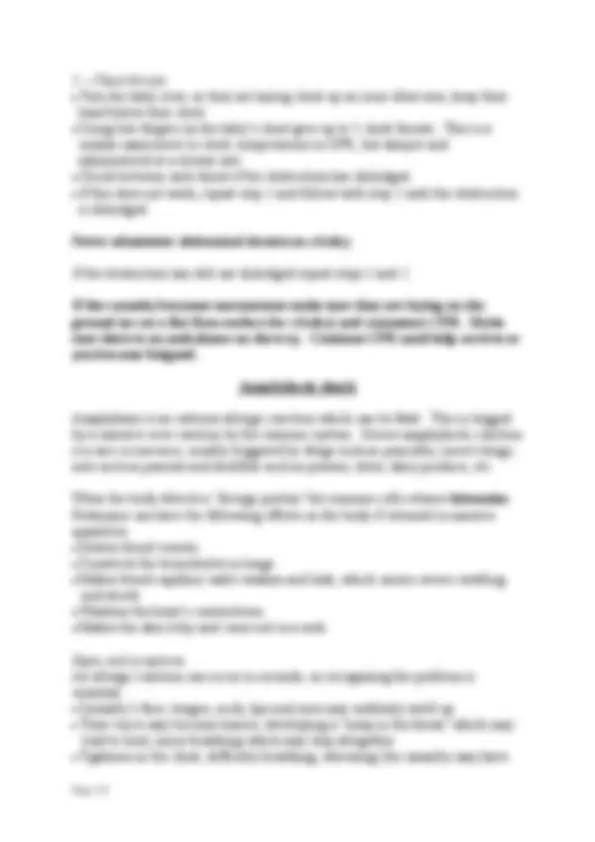
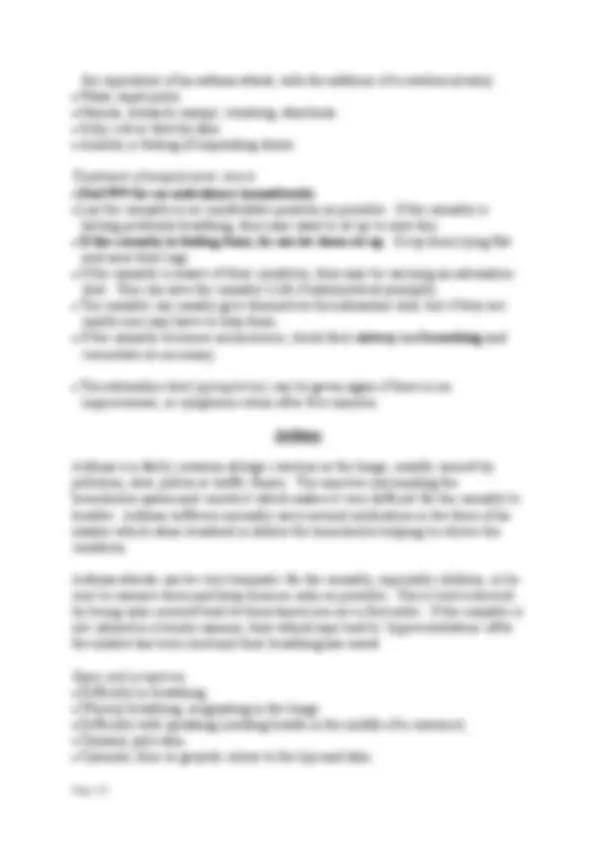
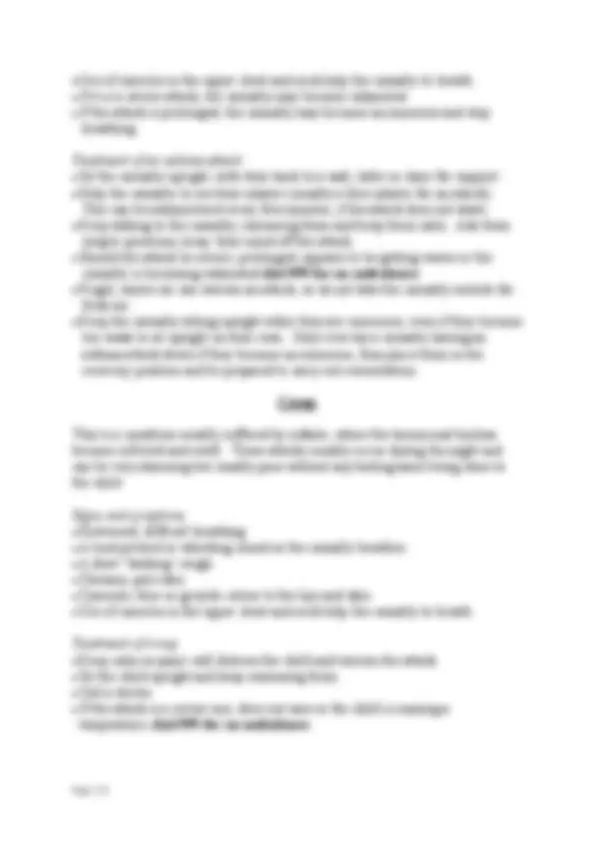
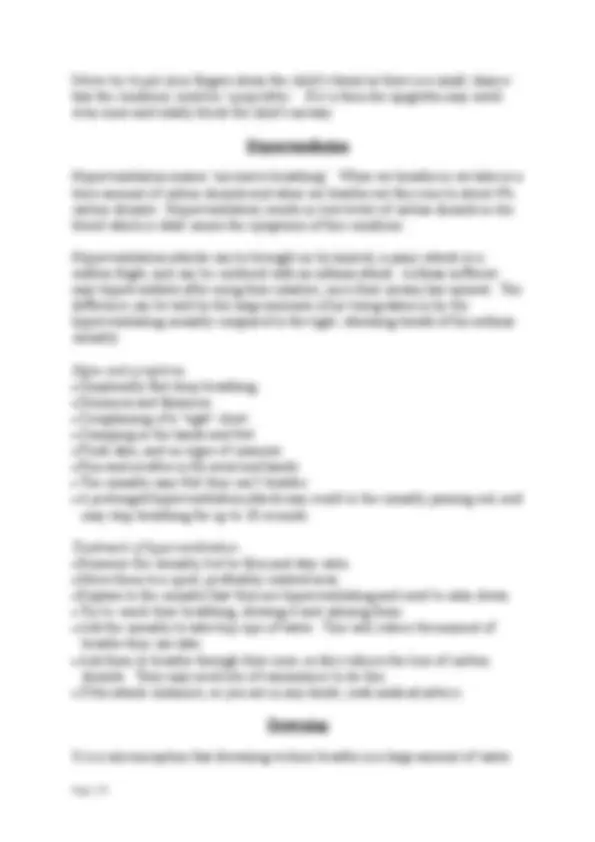
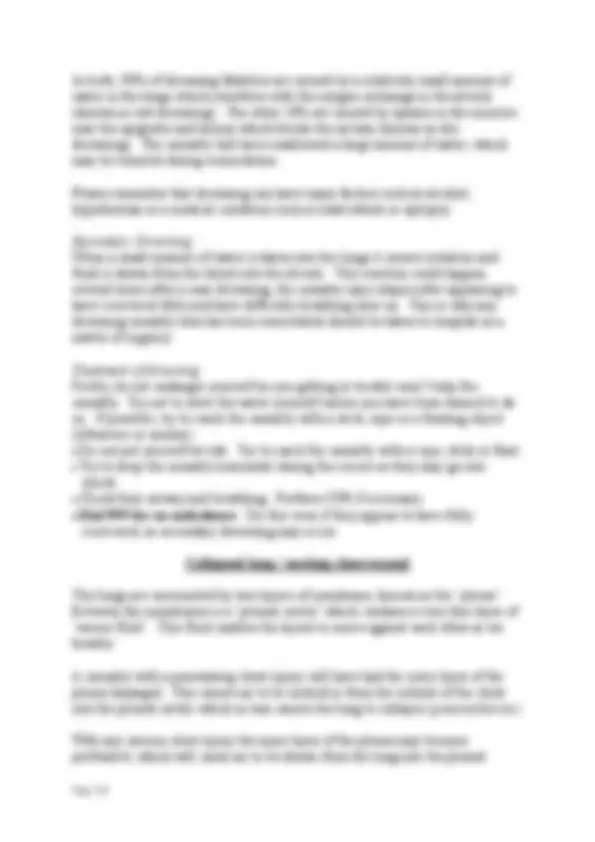
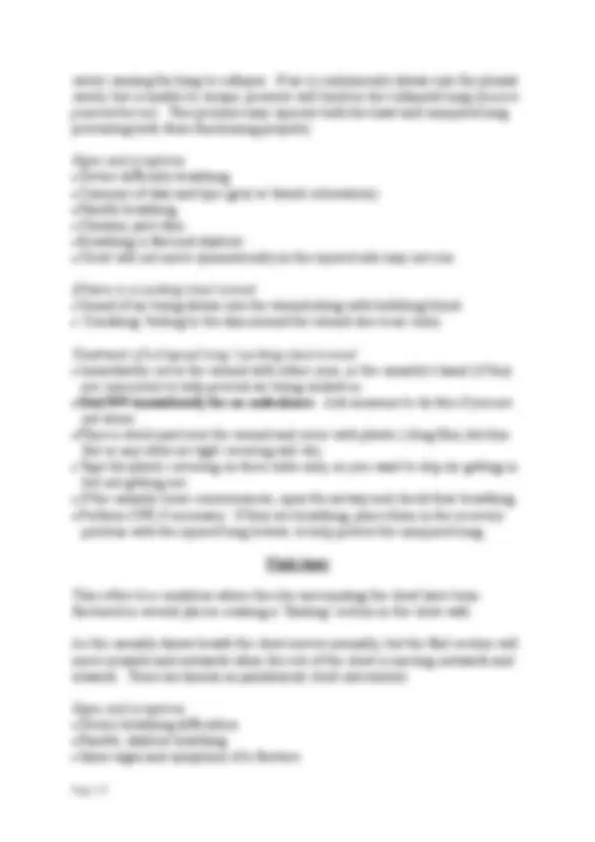
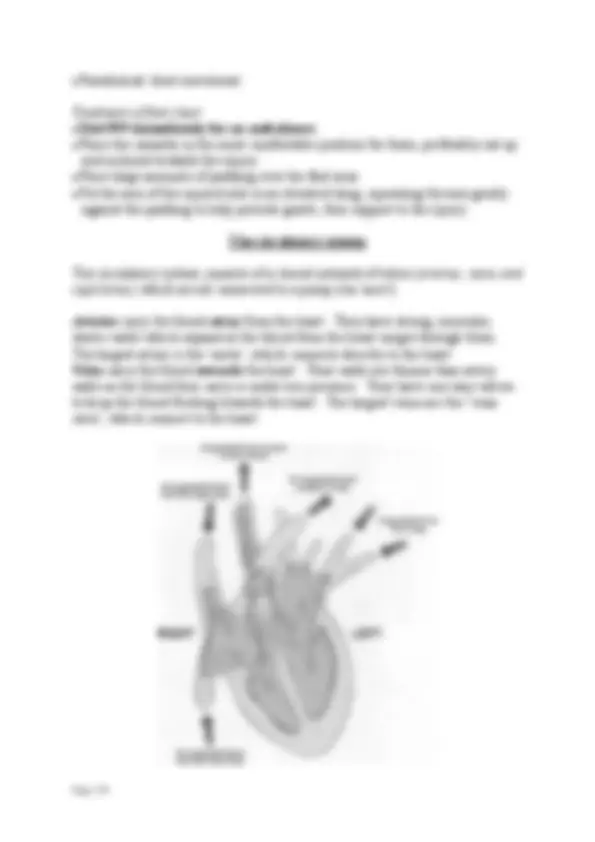
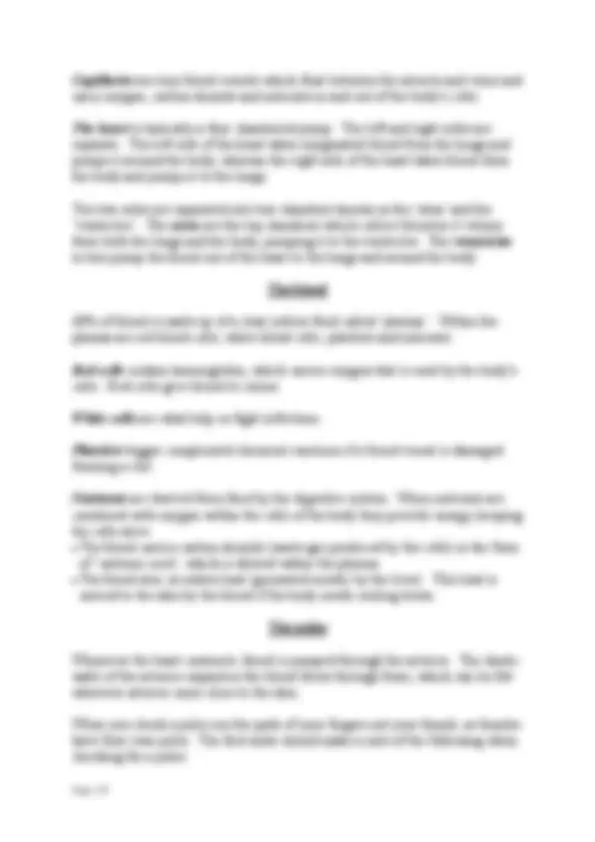
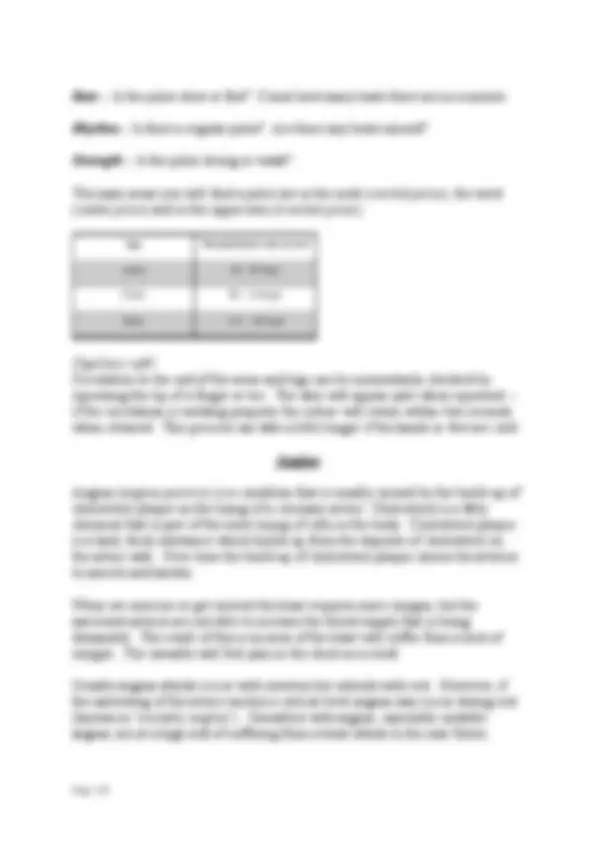
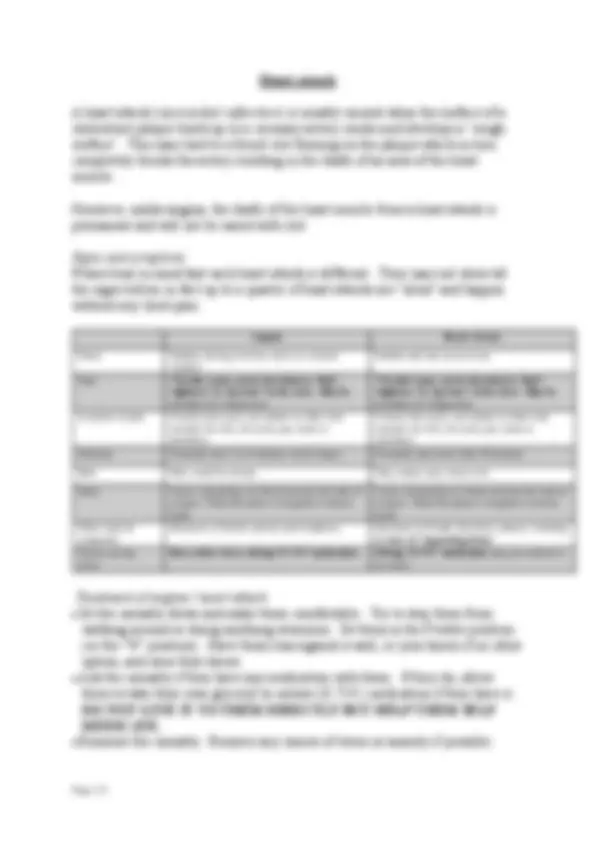
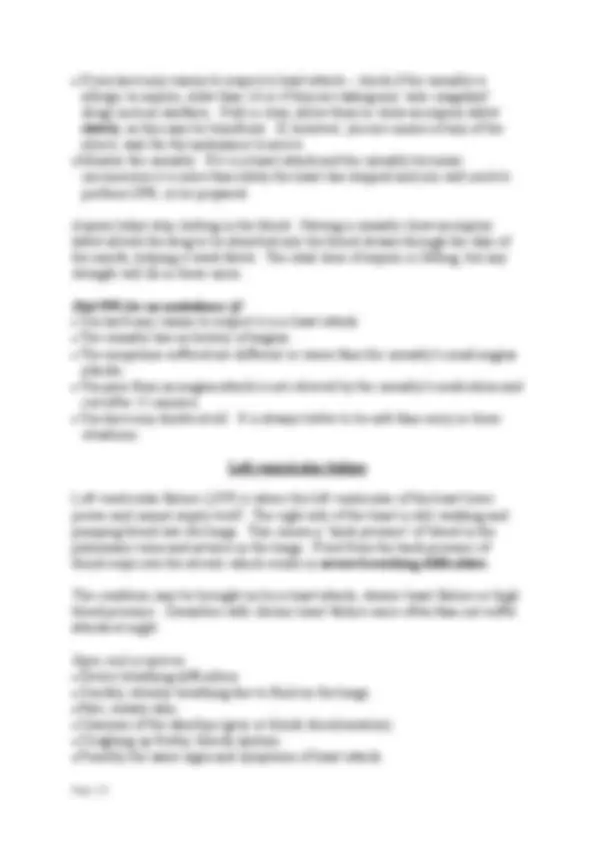
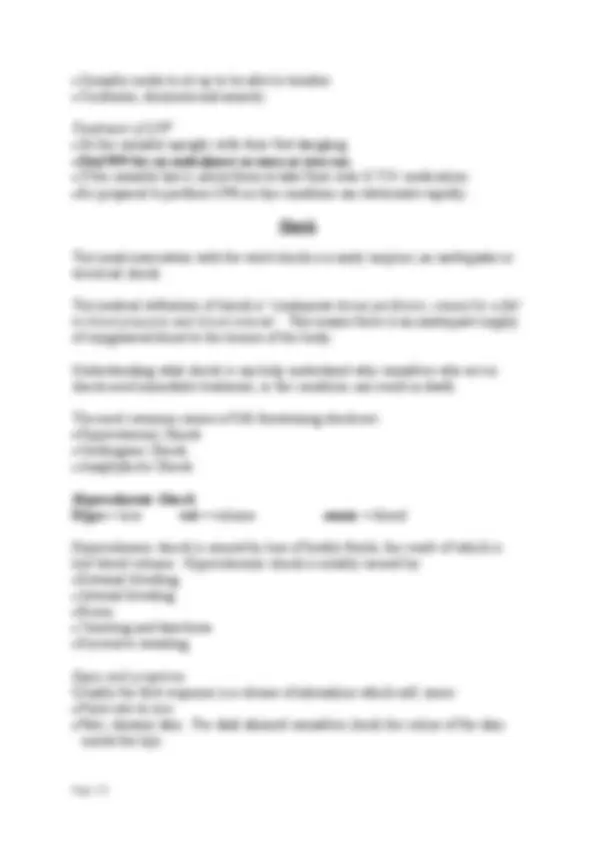
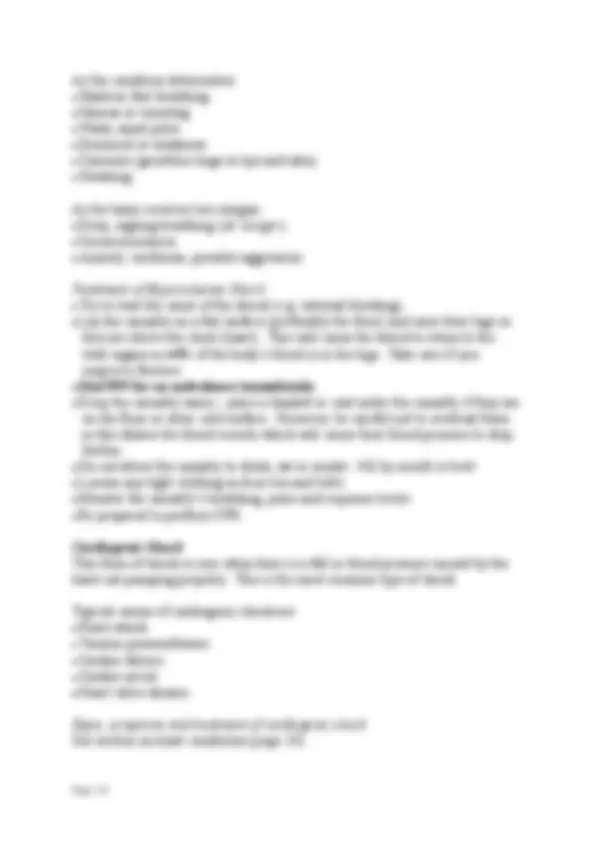
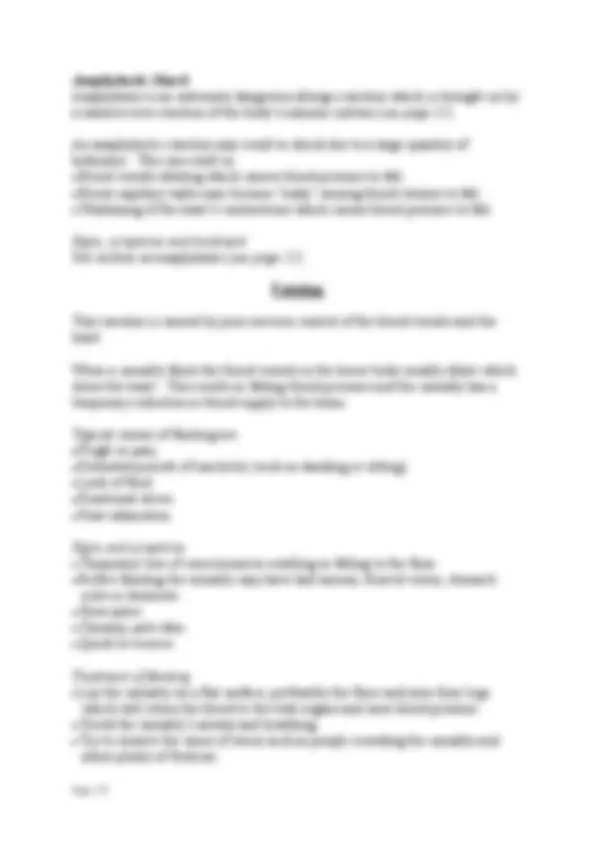

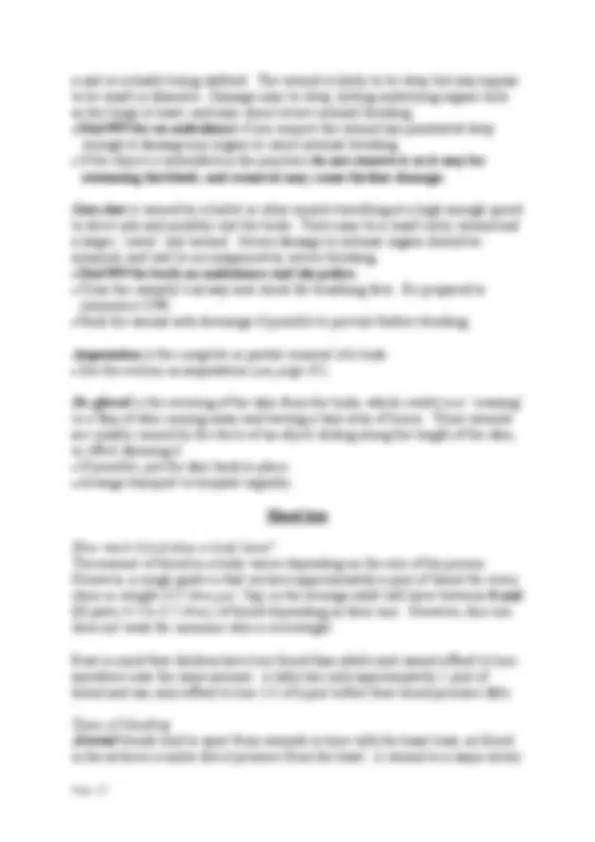
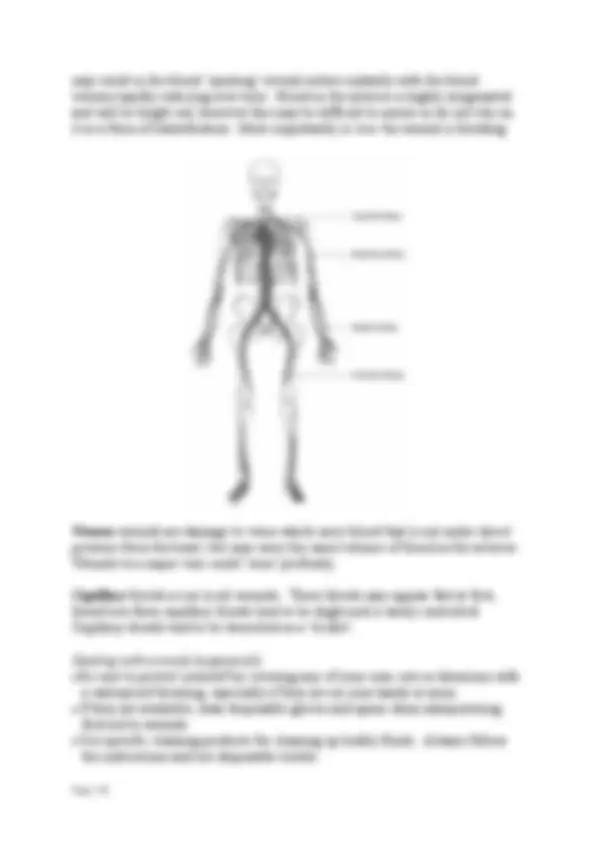
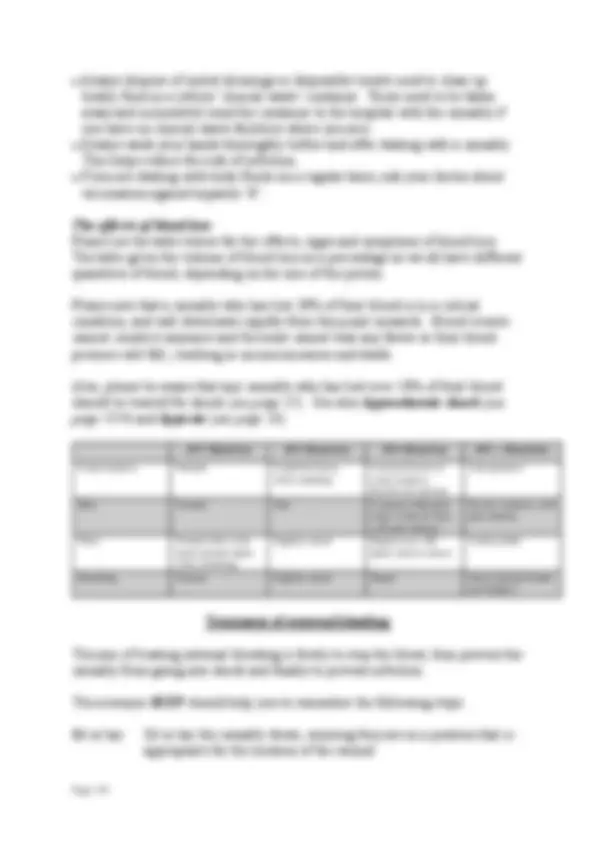
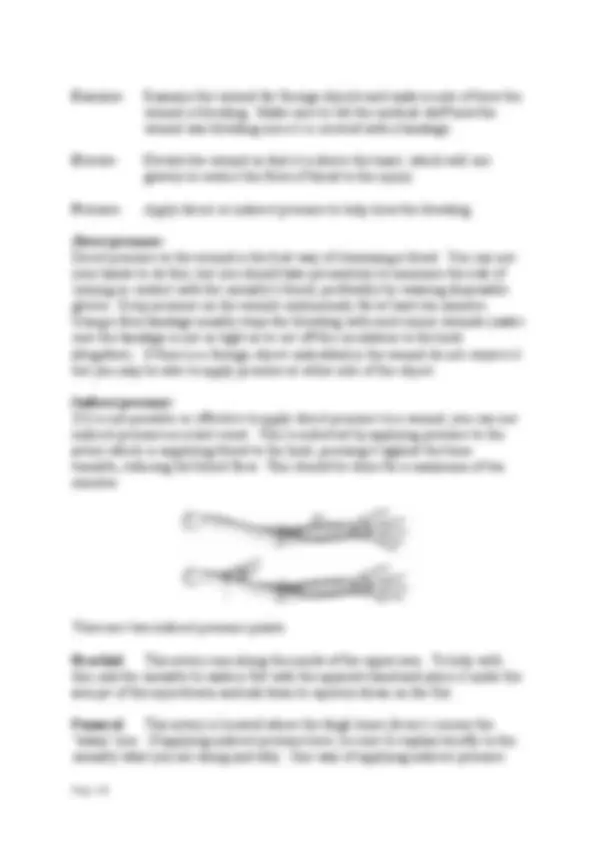
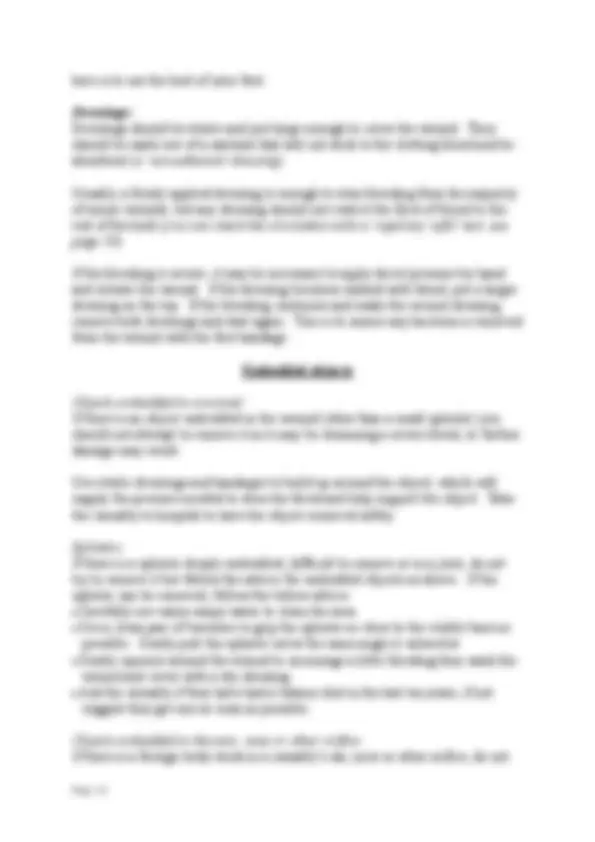
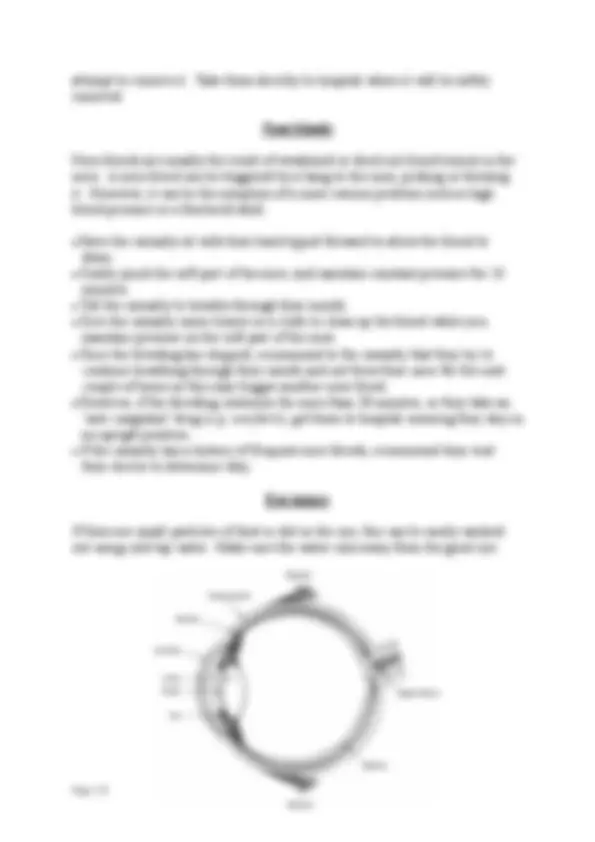
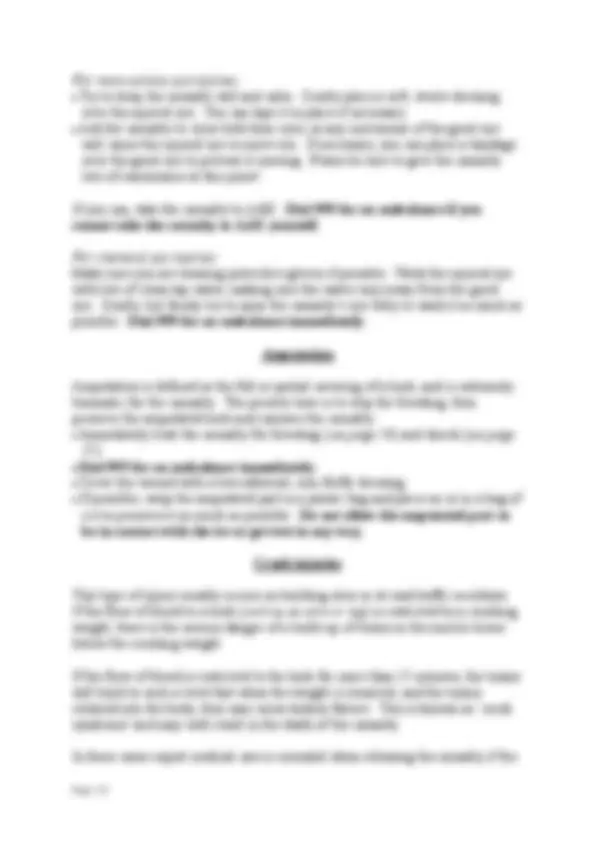
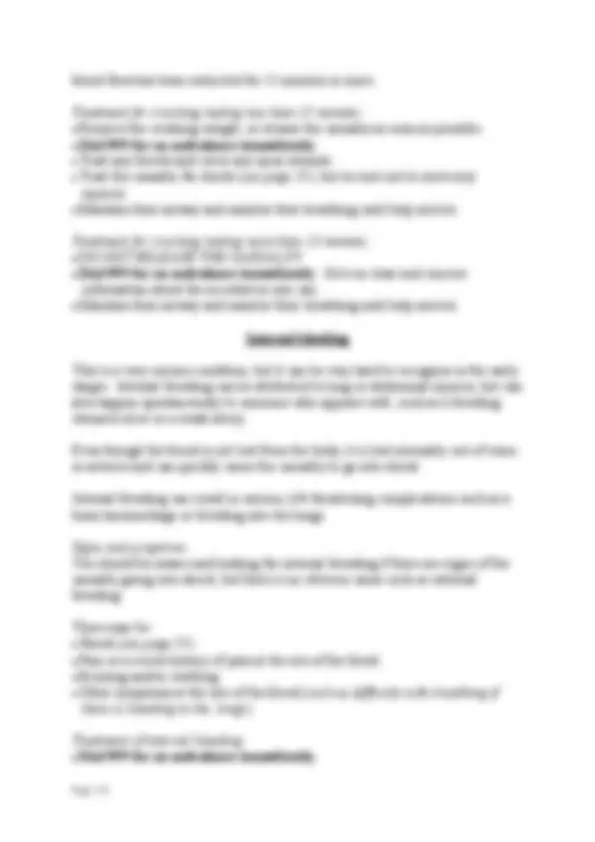
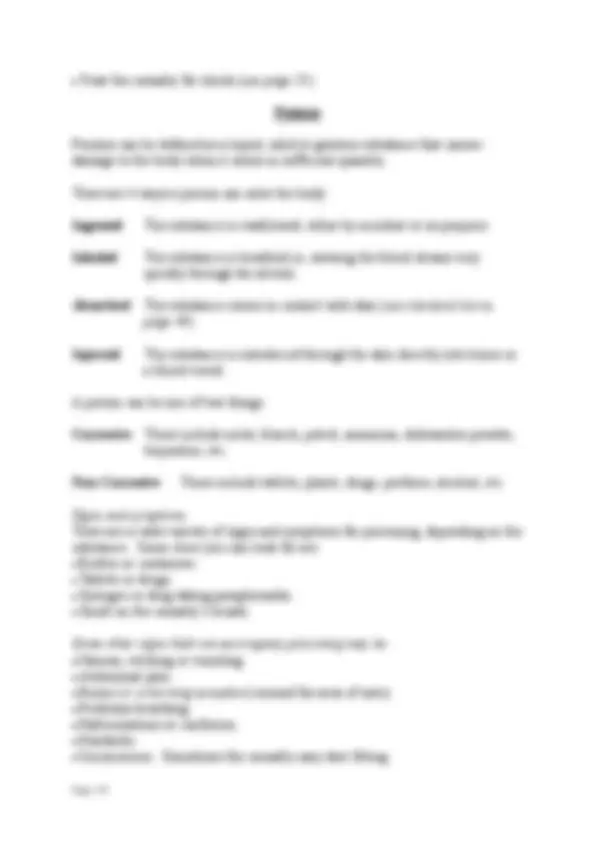
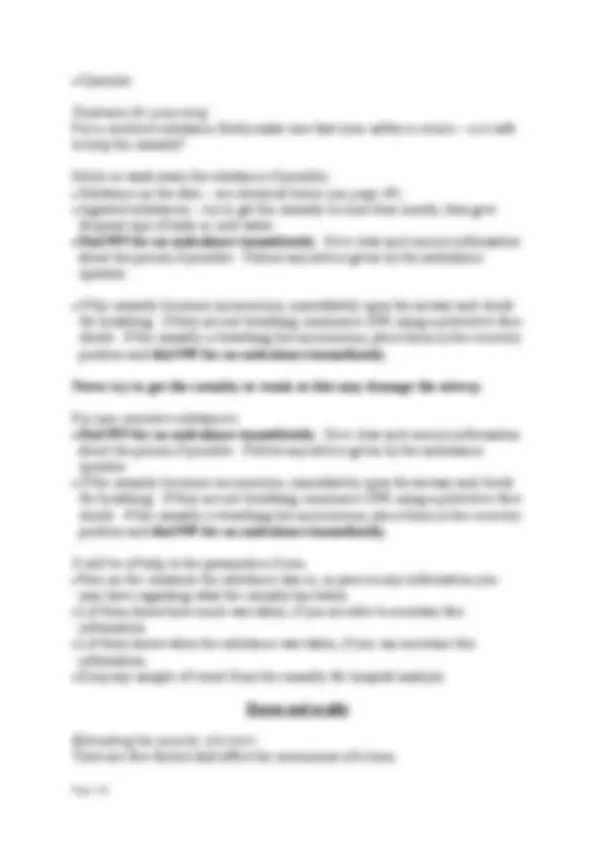
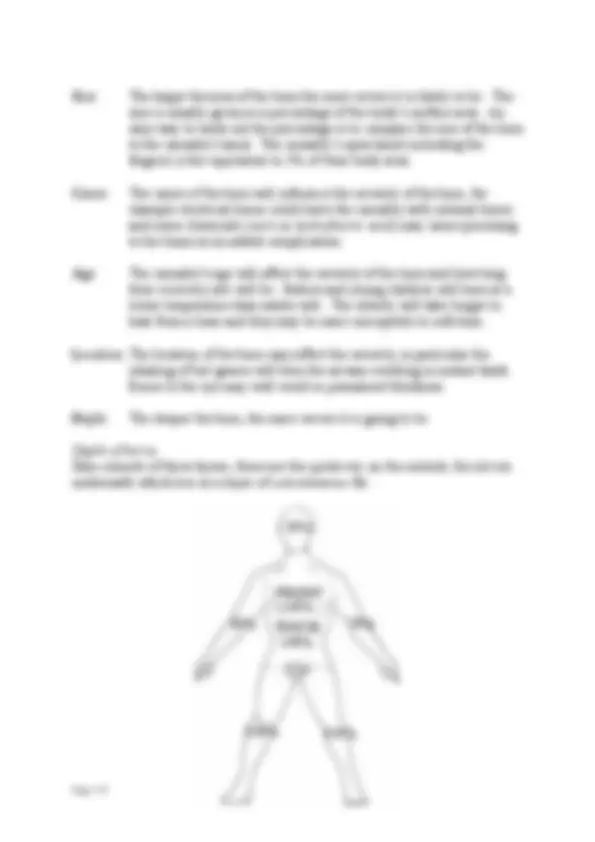
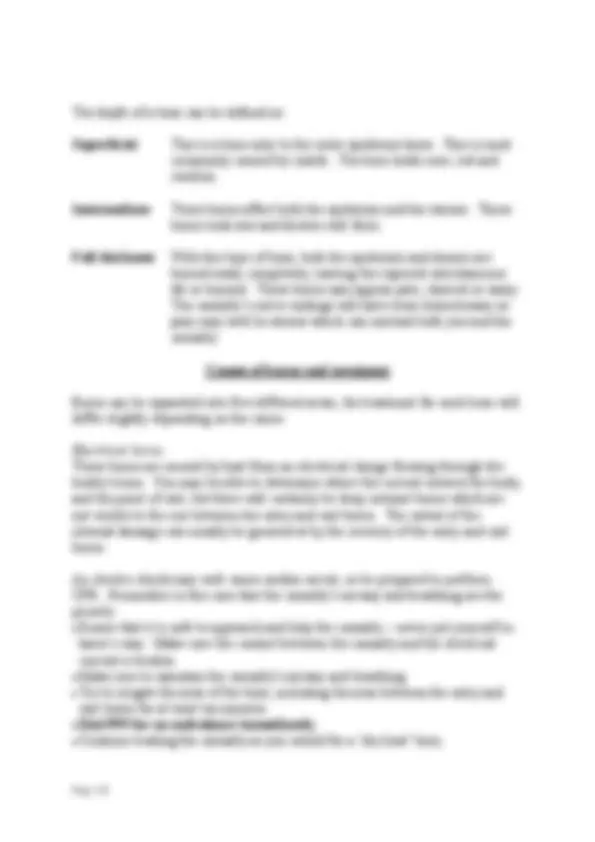
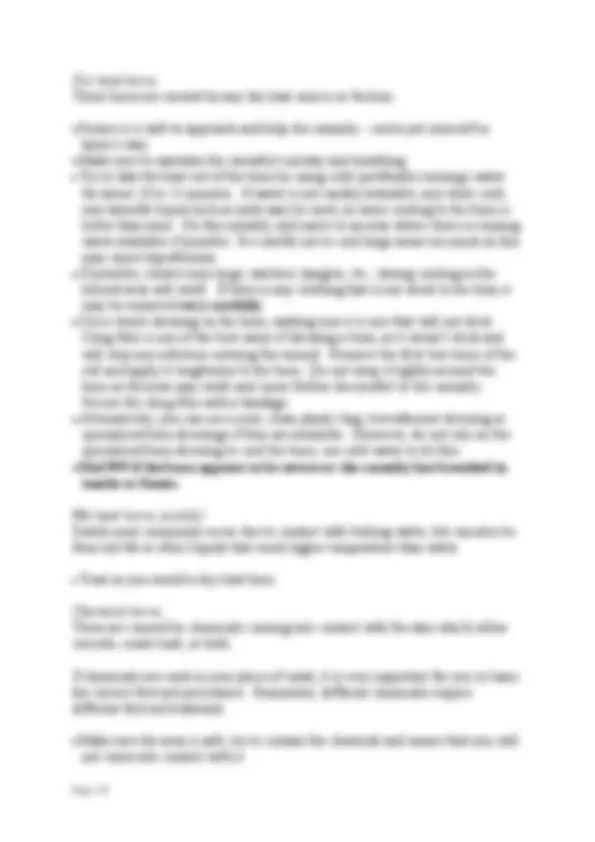
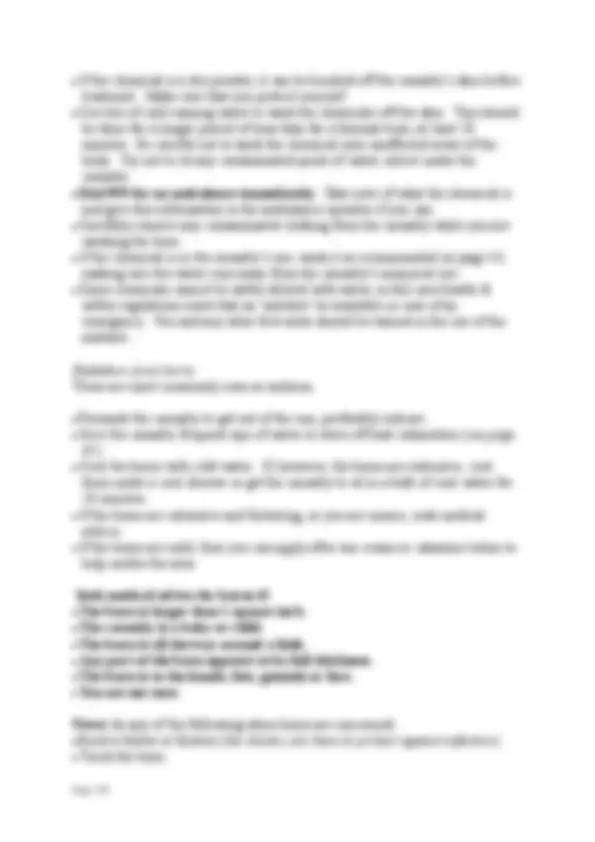
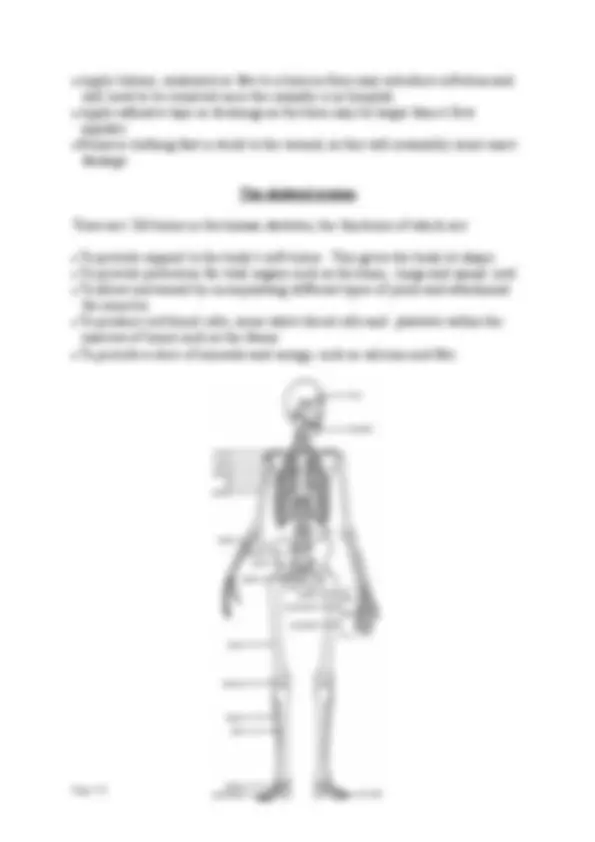
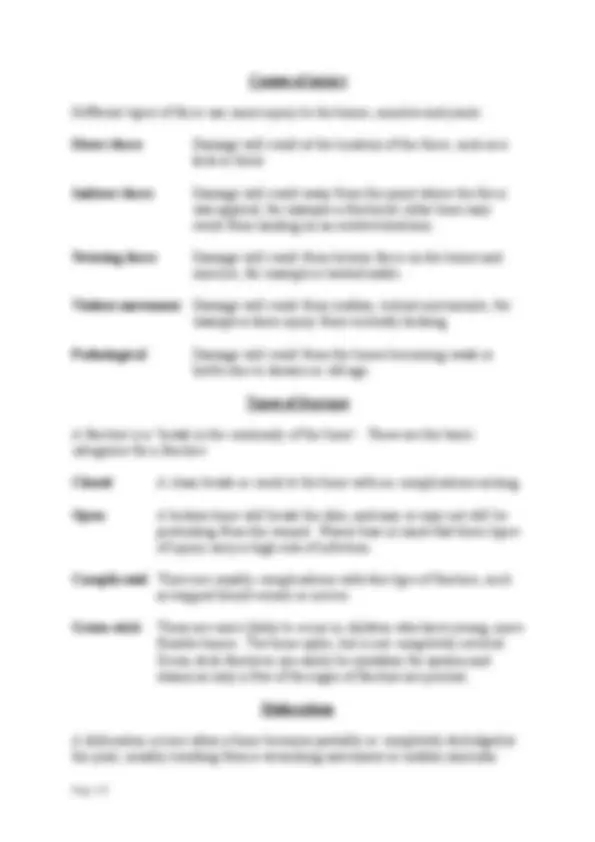
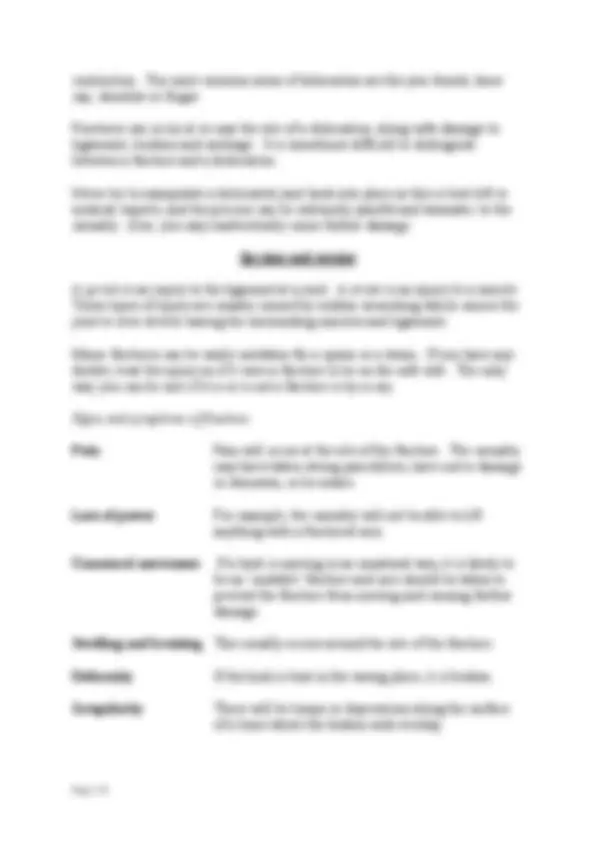
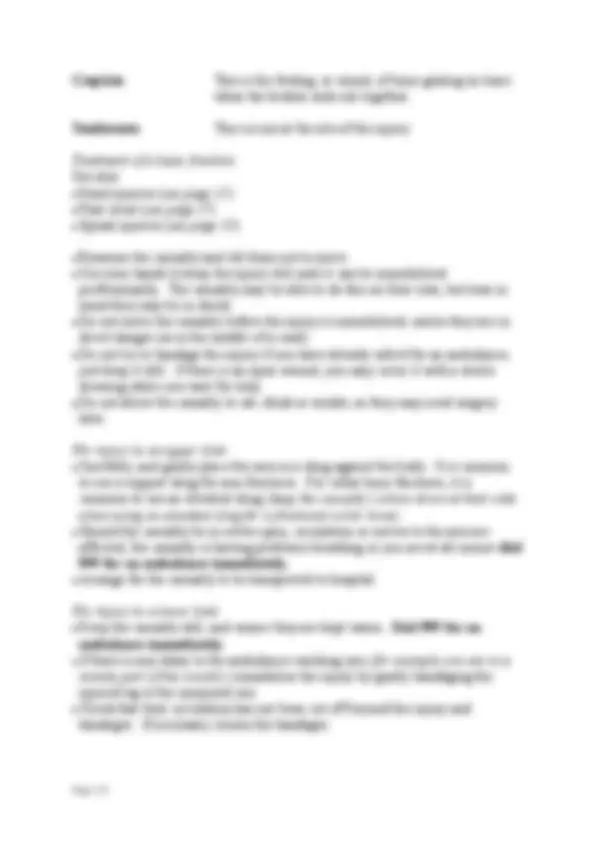
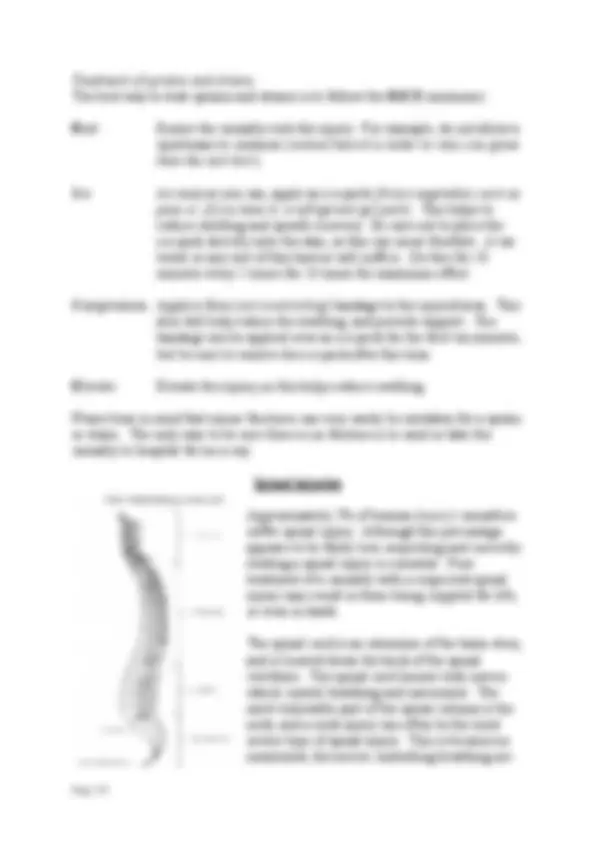
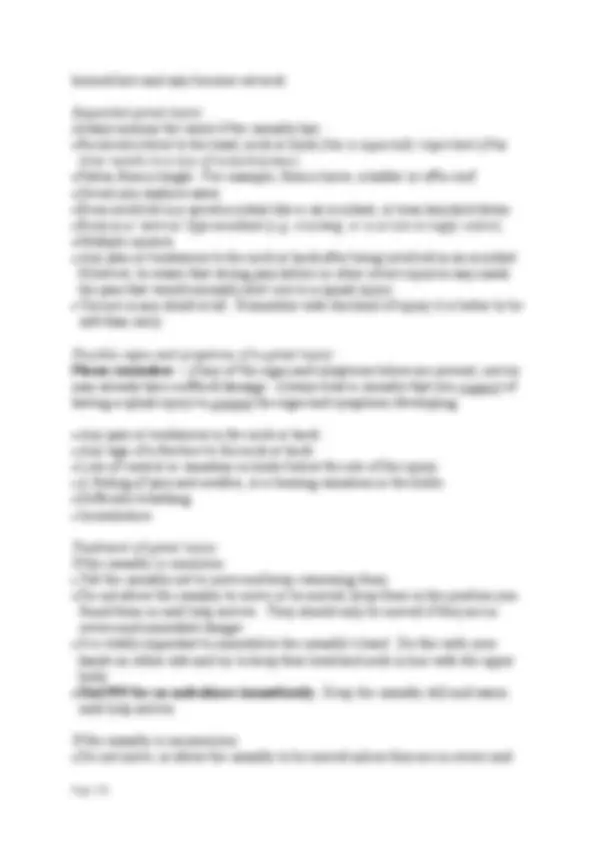
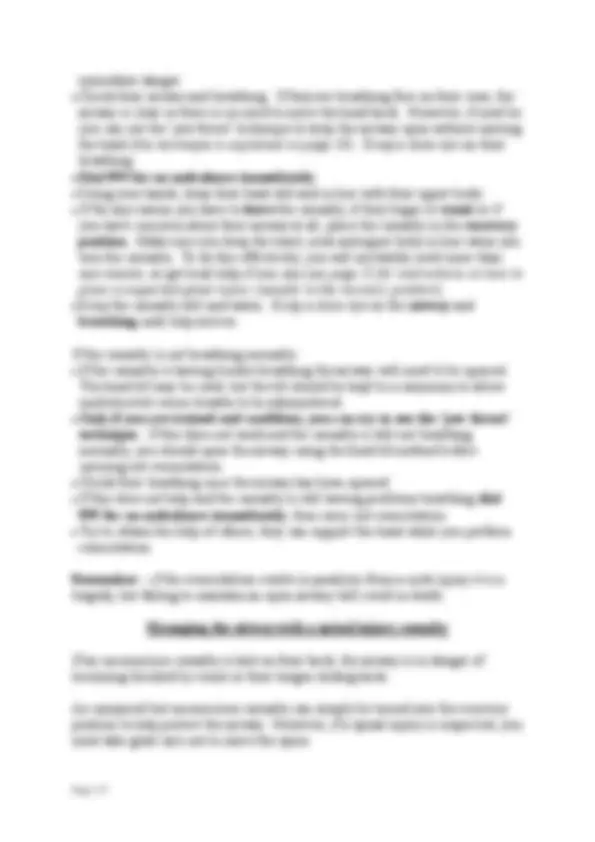
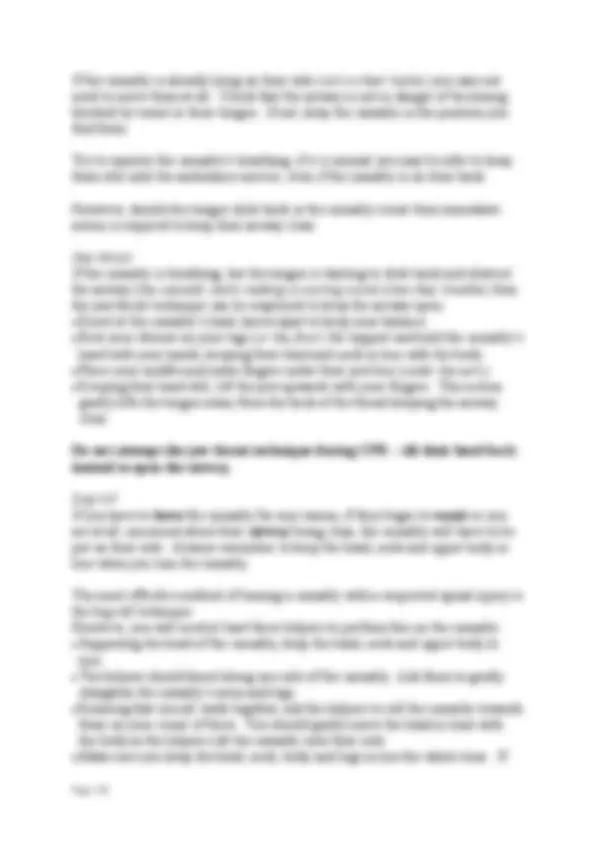
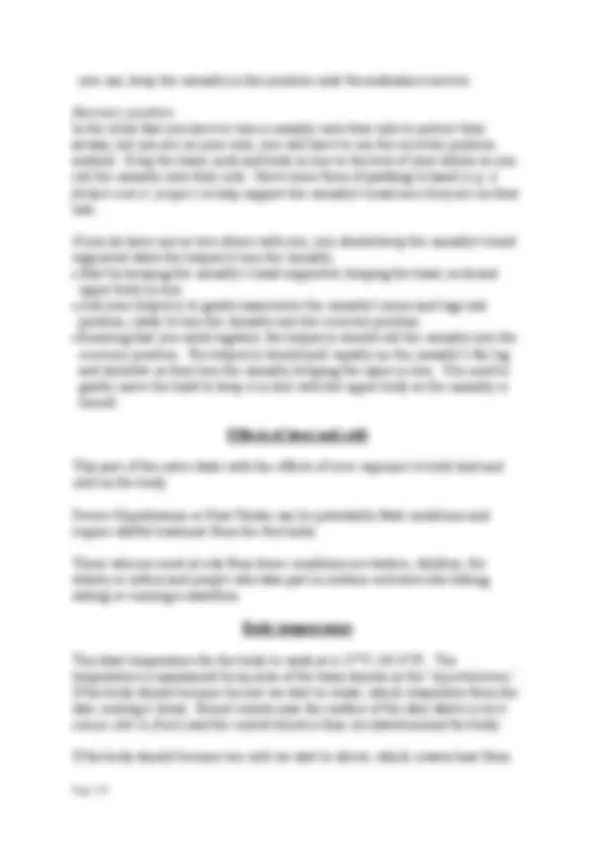
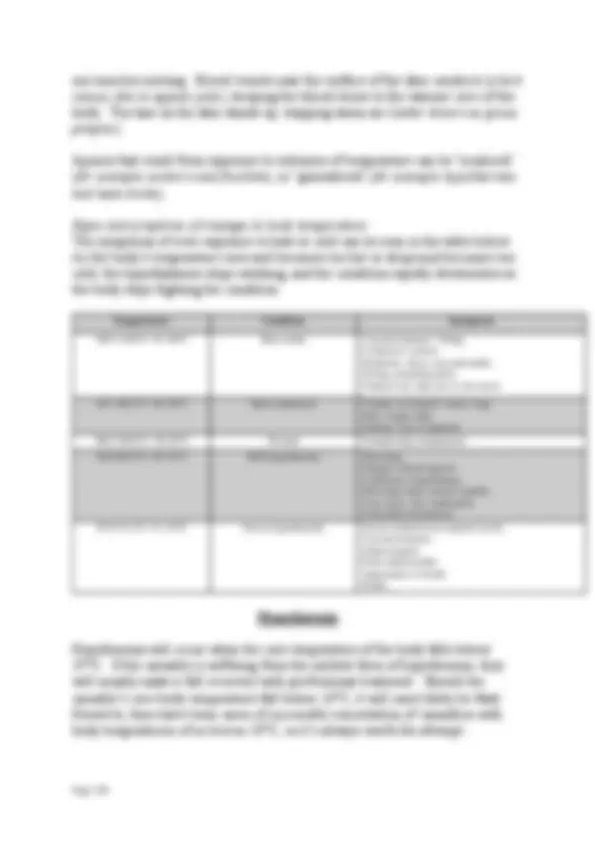
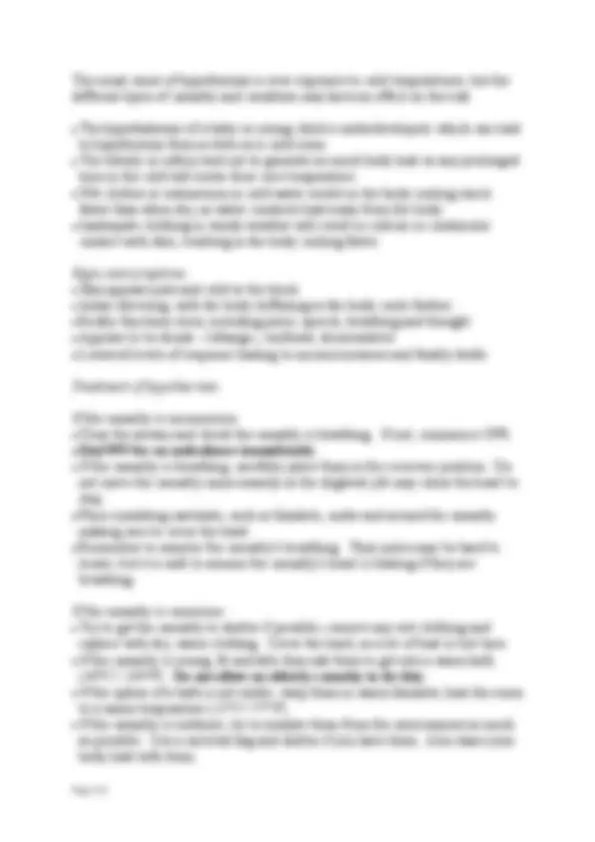
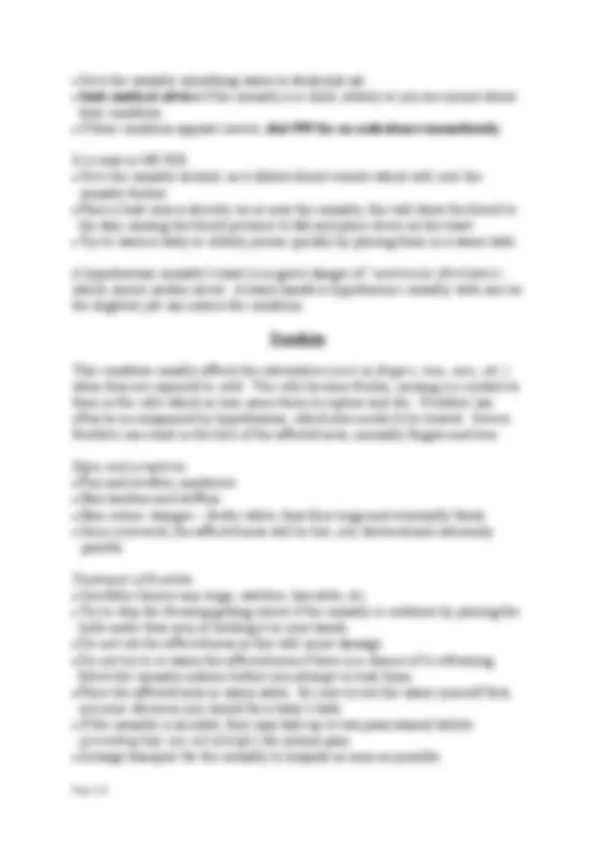
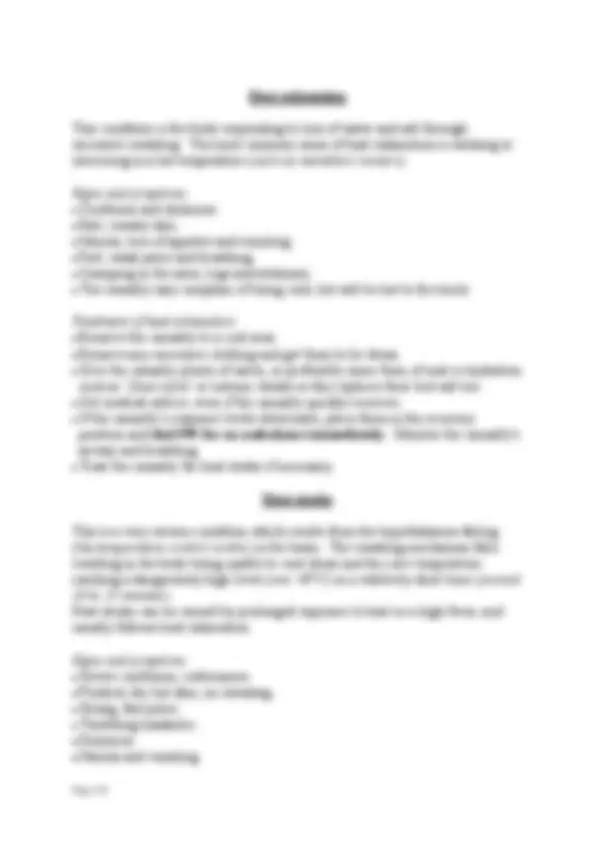
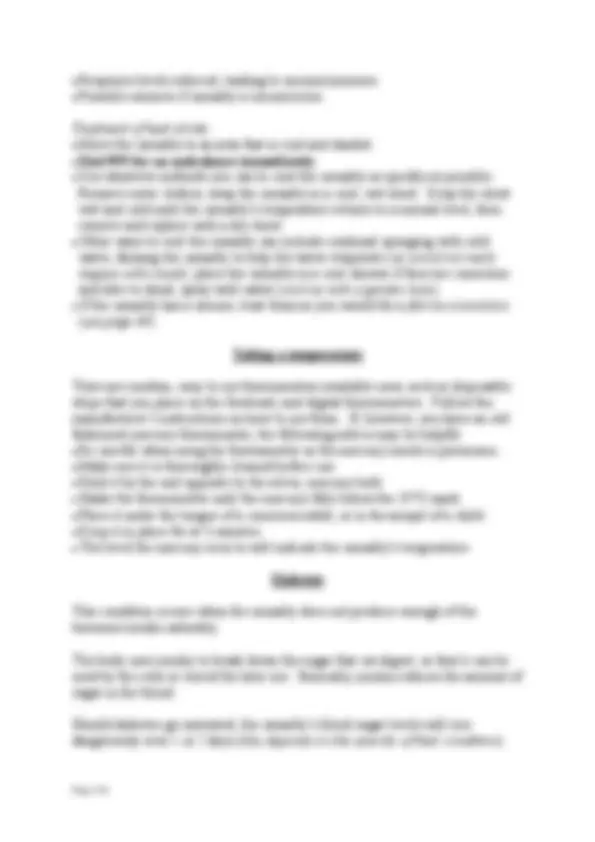
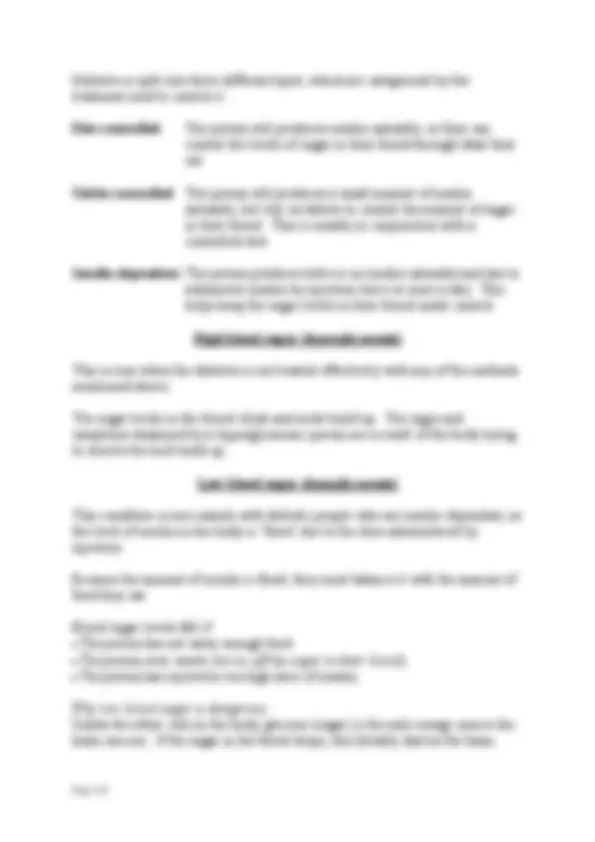
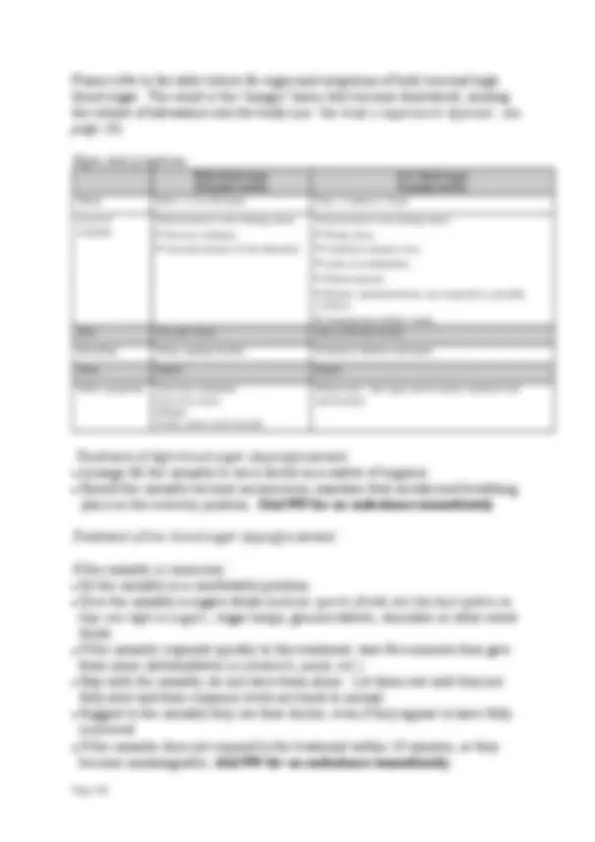
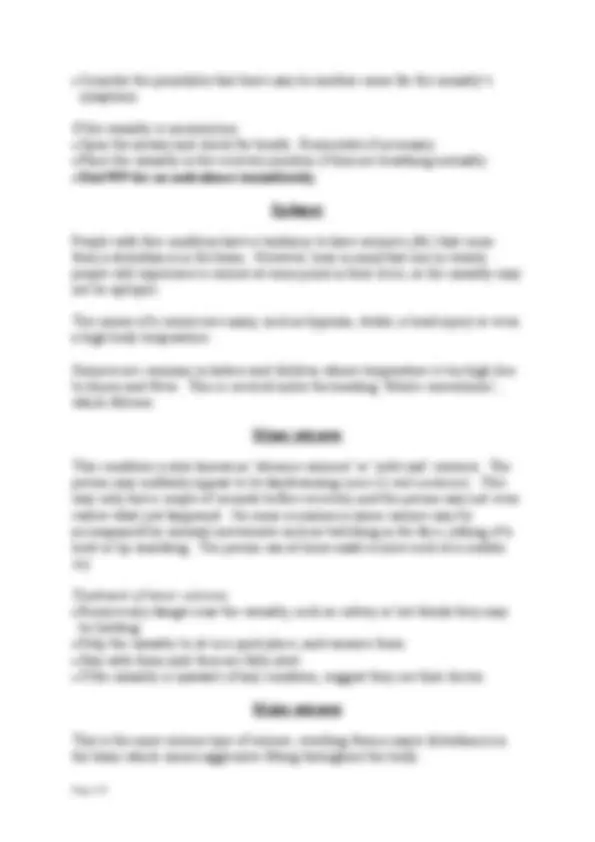
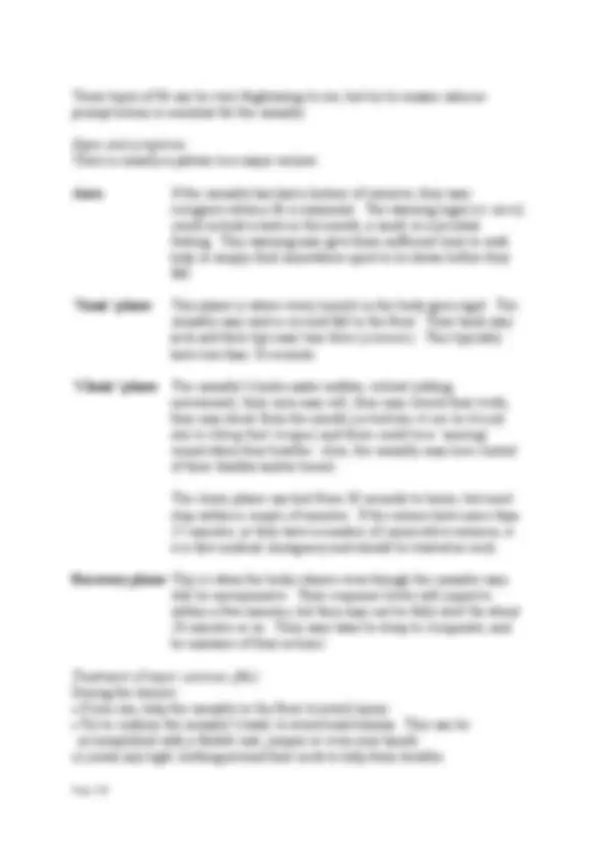
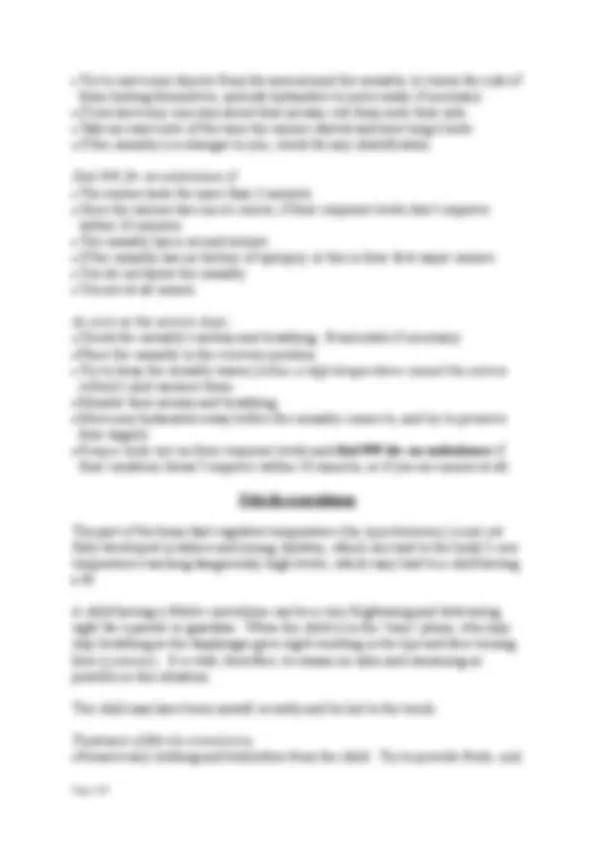
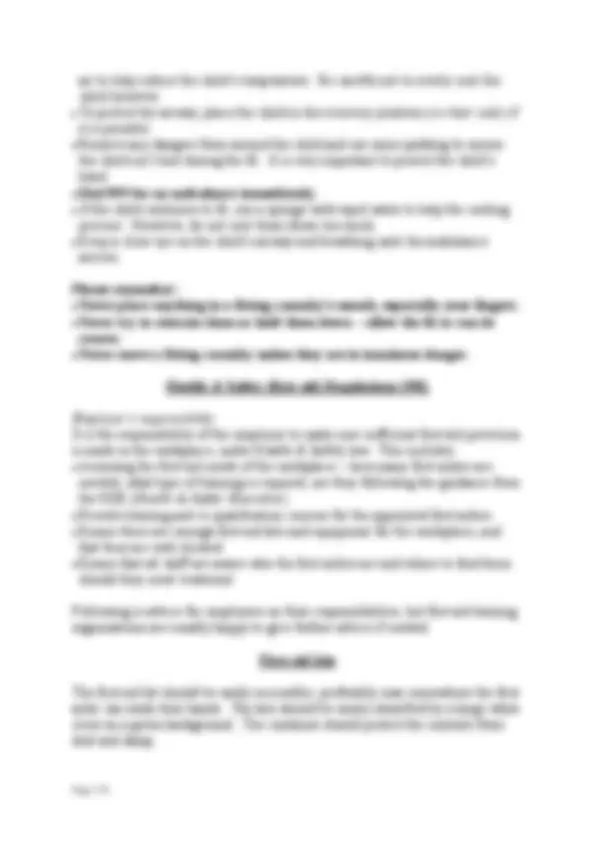
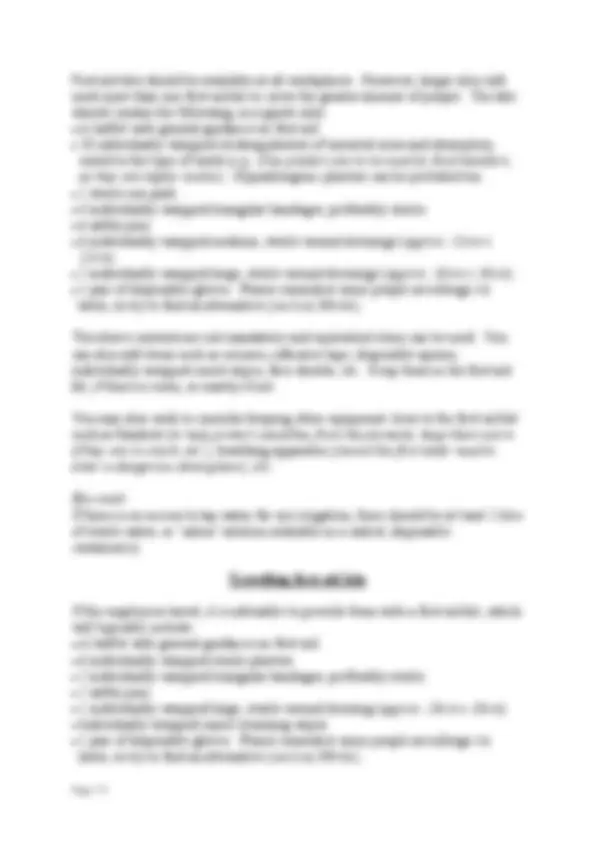
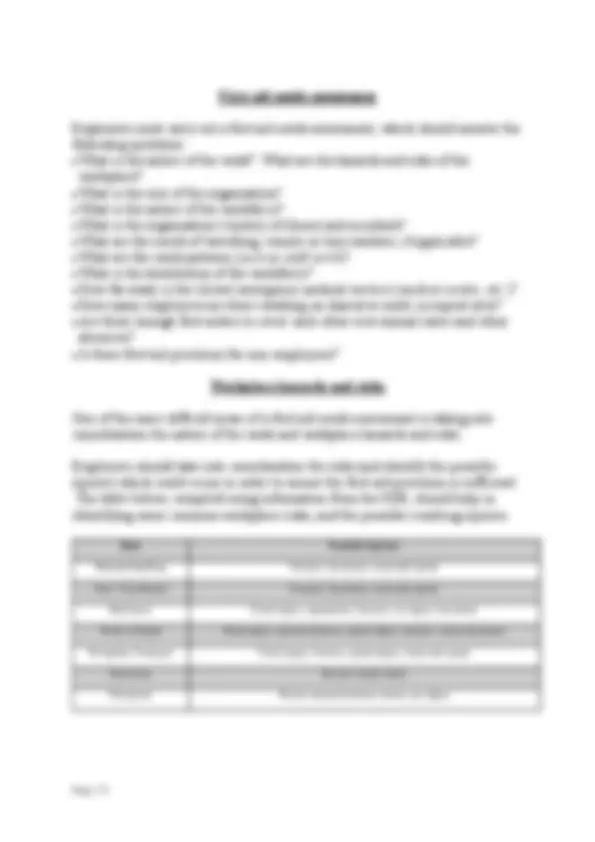
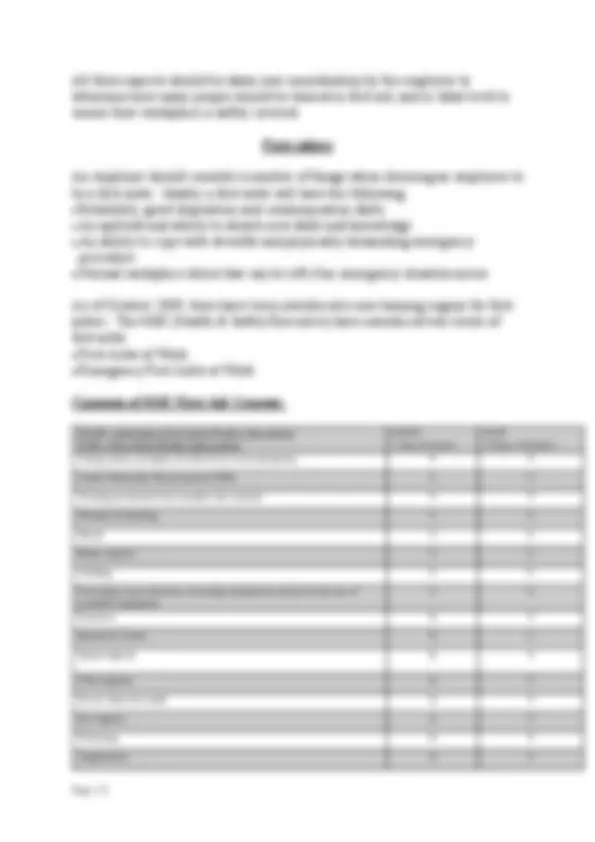
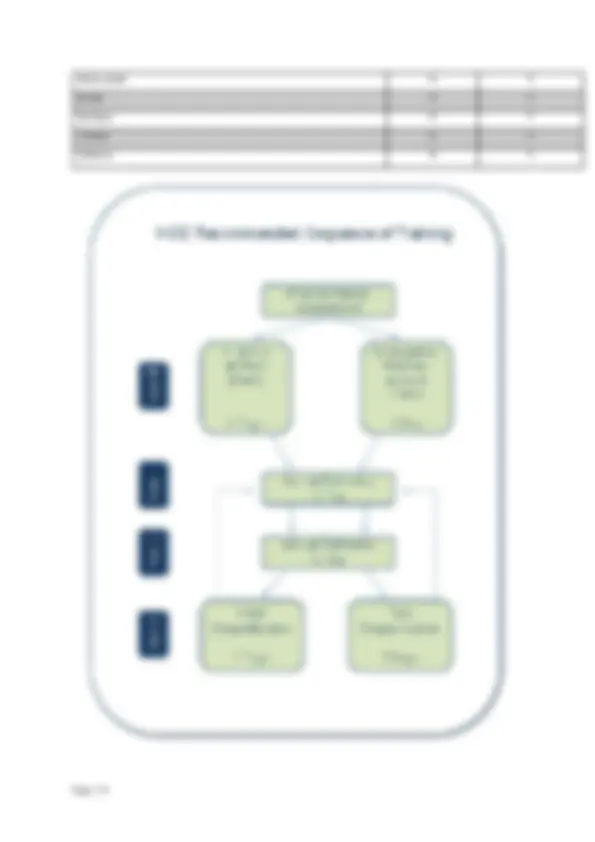
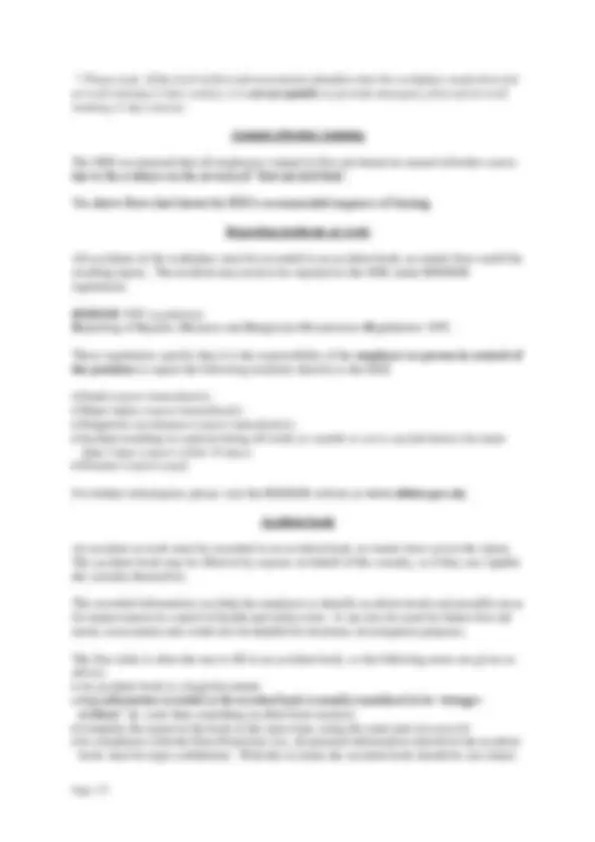
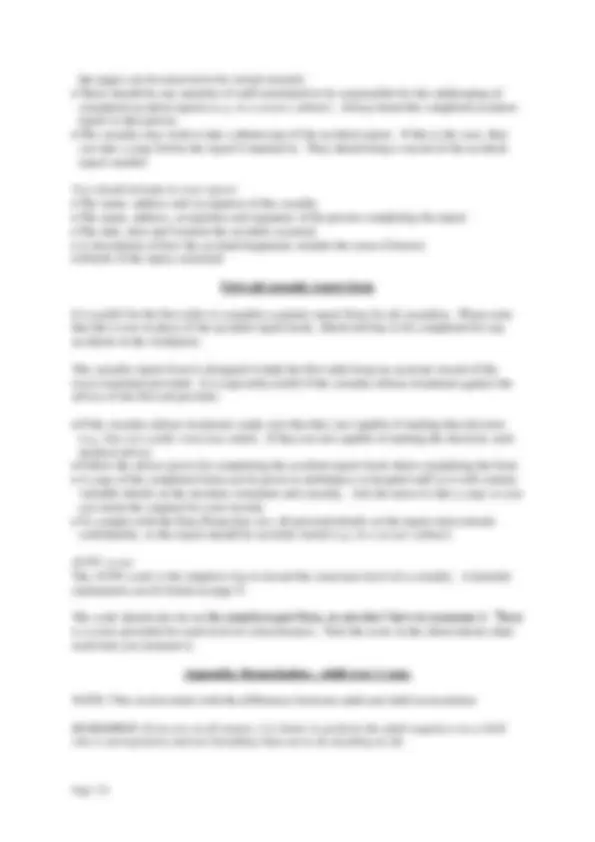
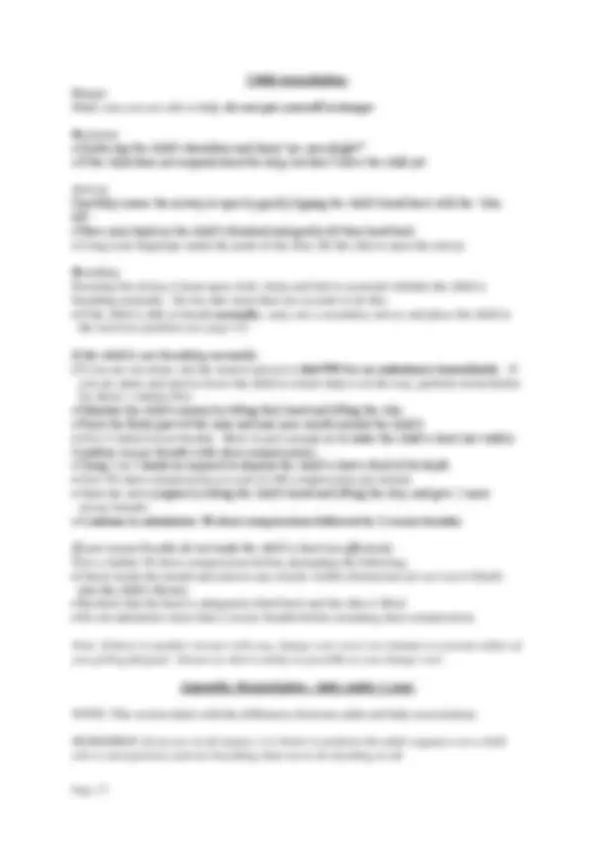
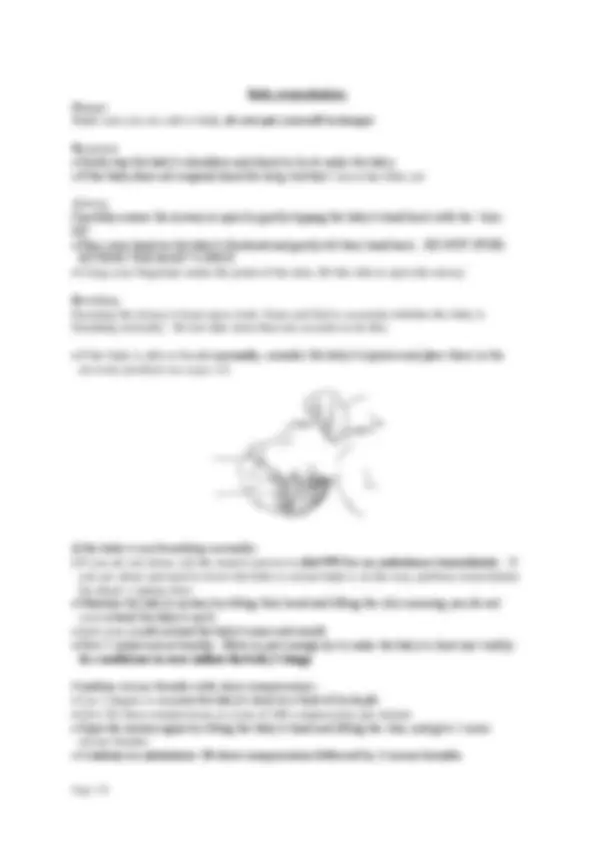
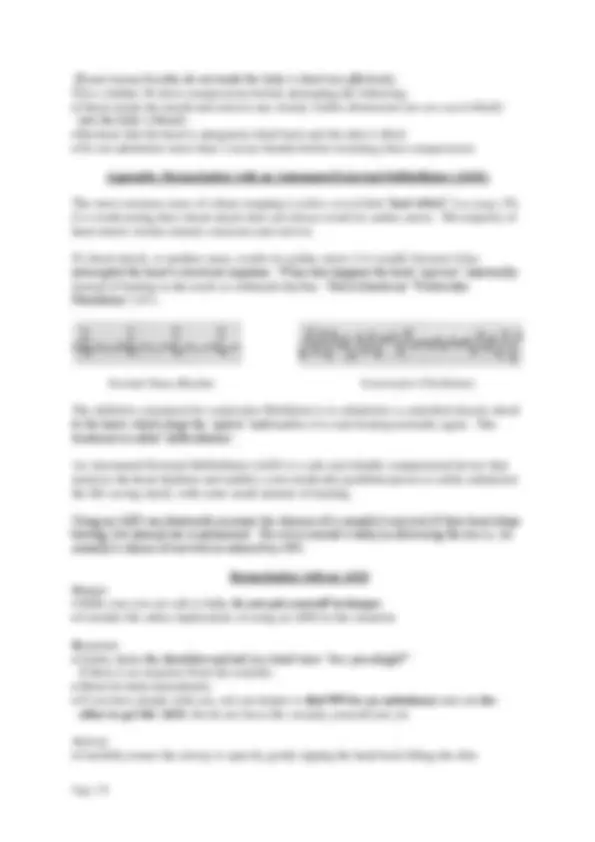
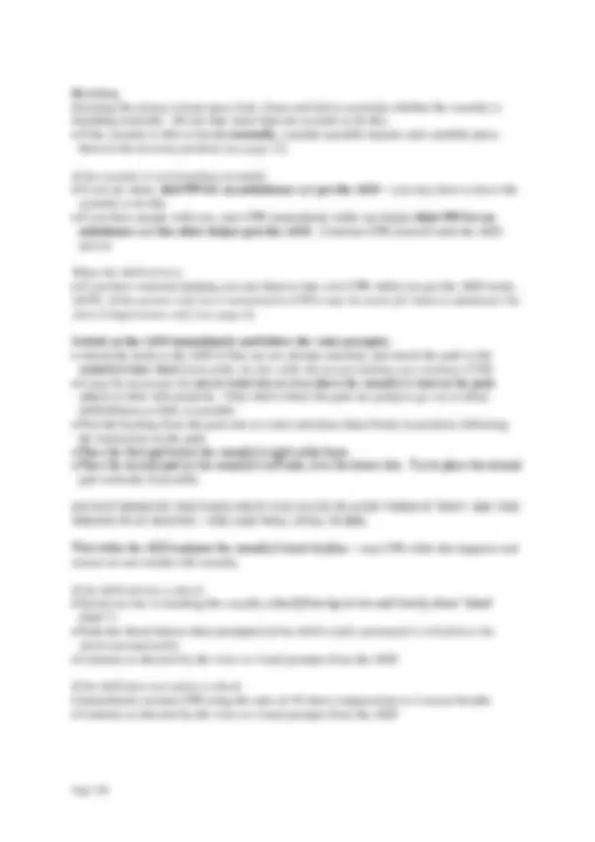
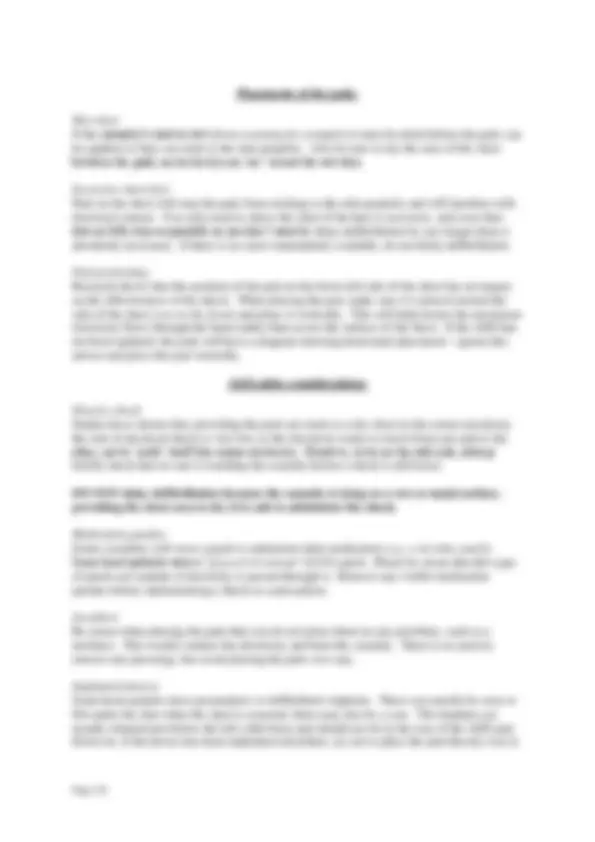
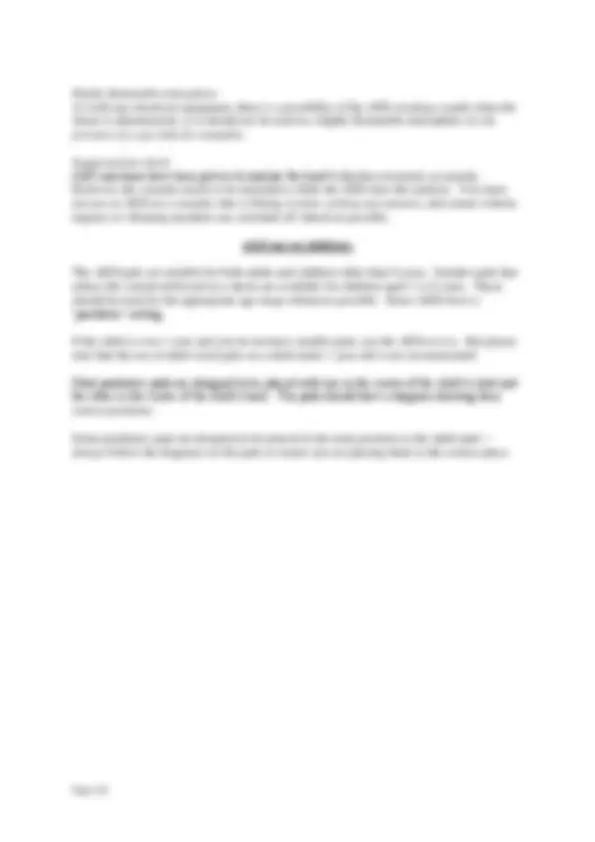
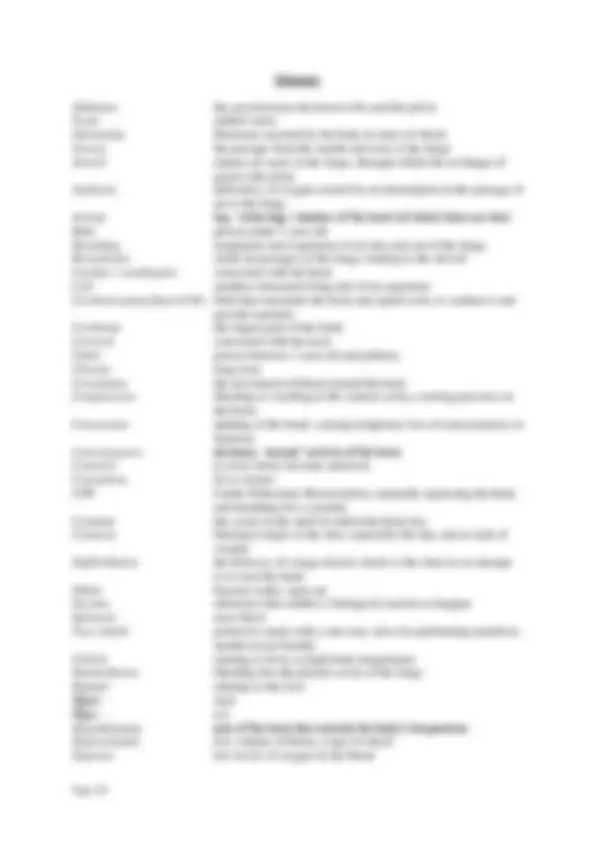
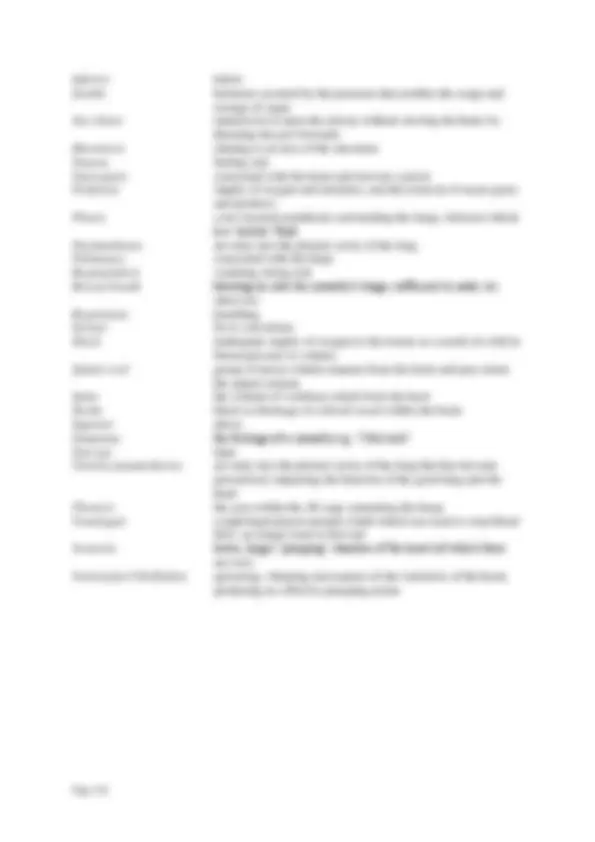


Study with the several resources on Docsity

Earn points by helping other students or get them with a premium plan


Prepare for your exams
Study with the several resources on Docsity

Earn points to download
Earn points by helping other students or get them with a premium plan
Community
Ask the community for help and clear up your study doubts
Discover the best universities in your country according to Docsity users
Free resources
Download our free guides on studying techniques, anxiety management strategies, and thesis advice from Docsity tutors
Essential information on identifying and treating various injuries, including head, neck, and spinal injuries, shock, and bleeding. It covers symptoms, causes, and first aid measures for each condition. It also includes a glossary of terms related to first aid.
Typology: Summaries
1 / 84

This page cannot be seen from the preview
Don't miss anything!













































































Imagine : Whilst feeding your child, they start to gag and appear unable to breathe. You have tried slapping them on the back, with no success. They seem close to losing consciousness, their lips are turning a definite shade of blue.
People rarely give first aid a thought, until the day they need it. The above scenario is the sort of every day occurrence that can so easily lead to tragedy.
However, with the correct first aid training anyone could, in the short term (until the arrival of the emergency services) save a life.
These notes have been designed to aid you with your first aid training. It is, however, not a substitute for hands on training from a professional first aid trainer, but a reference for you to look back on when you need to.
We hope the training you undertake with us will give you the knowledge and confidence to, if the worst happens, help keep someone alive.
Preserve life This doesn’t just refer to the injured party, but yourself and anyone helping you. Far too often, a helper will inadvertently put themselves in danger and subsequently be another casualty for the emergency services to deal with. Please take a moment to assess the situation, and make sure there are no threats to you before you step in.
Prevent the situation from getting worse If you are in no danger yourself, try to stop the situation from becoming worse by removing any obvious dangers (such as stopping traffic, clearing people away from the casualty, opening a window to clear any fumes, etc.). Also, act as quickly as you can to stop the casualty’s condition from worsening.
Promote recovery Your role as a first aider is, after ensuring that the situation can not get worse, helping the casualty to recover from their injury or illness, or stop their condition from getting worse. If the injury is severe, then the best you can do is try to keep them alive until the emergency services arrive.
The priorities of treatment
This is the course of action you should try to follow, providing the situation allows.
Primary survey (Airway → Breathing):
A. Make sure the casualty’s airway is clear. Do this by gently tipping their head back so that the front of the throat is extended.
B. Check if they are breathing normally. You can do this by placing the back of your hand near their nose and mouth. You are looking for about two breaths every ten seconds. If the casualty is breathing, then their heart is working, which means blood is being circulated around their body.
Secondary survey (Breathing → Bleeding → Bones): Once you are satisfied that the casualty is breathing normally, the second thing to do is make sure to treat any bleeding. This is to stem any blood loss and to ensure there is a steady supply of oxygenated blood to the casualty’s vital organs. If there is no bleeding, or you have dealt with any cuts, the next priority is broken bones.
have their heart ‘restarted’ with a defibrillator. These are carried on all ambulances, and can also be found in some public places (shopping centres, etc.). These days’ defibrillators are very sophisticated, and will talk you through the process, but you should be trained in the use of them before attempting to use one. However, even if you are trained to use one, you must call an ambulance first, as this will give the casualty the best chance of survival.
Even so, we need to keep the heart and brain oxygenated as best we can while help is on the way; this is when we start Cardio Pulmonary Resuscitation (CPR).
Cardio Pulmonary Resuscitation (CPR) – Primary Survey: D Danger – ensure the area is safe and find out what has happened Make sure that it is safe for you to approach the casualty. Do not put yourself in any danger, because if you get injured you won’t be able to help the casualty. Remove any danger from the casualty, or if that is not possible, and it is safe to do so, try to move the casualty away from the danger area. Try to find out what happened, making sure that you are safe doing so. DO NOT PUT YOURSELF IN ANY DANGER. How many casualties are there? Can you cope with the situation?
R Response – is the casualty conscious? Try to get a response from the casualty. Gently shake their shoulders, shout and clap your hands in front of them, pinch their underarm or fingernail to get a pain response. If they do not respond, immediately shout for help, or call 999 if you have a mobile phone on you. Whatever you do, do not leave the casualty alone.
A Airway – clear the airway Clear the airway by placing your fingertips under the casualty’s chin and lifting, so the front of the neck is extended. Simultaneously placing your other hand on their forehead to gently tilt the head back.
B Breathing – is the casualty breathing normally? When their airway is cleared, check if they are breathing normally. You are looking for two breaths in ten seconds. Take no longer than this to assess their breathing, as every second counts. Check whether their chest and abdomen are rising and falling. Listen for breath (more than a sporadic gasp). Use the back of your hand (lick the back of your hand if that will help) or your cheek to feel for any breath from the casualty.
This will all determine if the casualty is breathing normally. If they are, you will need to place them in the recovery position, which will be covered later in the notes.
If the casualty is not breathing normally: The first thing to do in this situation is call 999 for an ambulance. If someone is with you, get them to do this so you don’t have to leave the casualty. If you are alone, and do not have a mobile with you, you may need to leave the casualty to do this. However, it is vital that an ambulance is called, as the casualty will stand a much better chance of survival with help on the way. Once the ambulance is called, start CPR:
Place the heel of one hand in the centre of the casualty’s chest. Place the other hand on top and interlink your fingers. Take a position next to the casualty’s chest, kneeling at whichever side feels more comfortable for you. Press down firmly on the casualty’s breastbone current guidelines suggest pushing down to a depth of 6cm ) then release the pressure, but try not to lose contact with the casualty. This is known as a chest compression. When applying pressure, avoid doing so on the ribs, upper abdomen or the end of the casualty’s breastbone. Each compression should take the same amount of time. Carry out 30 chest compressions at a speed of 100-120 compressions per minute. After 30 chest compressions, you must administer two rescue breaths (see images below).
In an ideal situation, the casualty will be on a flat hard surface to be able to administer CPR. However, this isn’t always the case, and you may find that you
Should your rescue breaths not be effective, follow the steps below: Give a further 30 chest compressions. Remove any visible obstructions in the casualty’s mouth. Make certain their airway is clear by tilting their head back and lifting the chin. If the airway is not clear, the breath you give will not fill their lungs.
Do not give the casualty more than two rescue breaths before continuing with chest compressions.
If you have someone with you, take it in turns to administer chest compressions. Every 1-2 minutes, change over so one person administers chest compressions while the other gives the rescue breaths. Ensure there is as little delay in swapping as possible, so the casualty is constantly receiving CPR.
Continue CPR until: The emergency services arrive to take over. You become too fatigued to continue.
Resuscitation for babies and children: Understandably, some people are reluctant to perform CPR on a child or baby for fear of causing further harm to them. However, a child in this state is likely to suffer far worse consequences if CPR is not administered. Please keep that in mind should the situation ever arise.
CPR on a child is very similar to CPR on an adult. There are only a few minor modifications to the process, which are detailed below:
Give the child 5 rescue breaths before starting CPR, then switch back to 30 chest compressions to 2 rescue breaths. If you are alone, perform CPR for about a minute before going for help.
Chest compressions on a child should be about one-third of the depth of the chest. For a baby under 1 year old, only use two fingers to administer CPR. For a child over 1 year use either one or two hands to compress the chest, again one third of the depth of the chest.
Full details on child CPR is covered later in the notes.
Resuscitation with chest compressions only An adult cardiac arrest casualty will probably still have oxygen in their blood stream. If there is any reason you cannot give the casualty rescue breaths, you can still help the casualty by giving them ‘chest compression only’ resuscitation. Although not ideal, it will still circulate the residual oxygen in their blood to their vital organs, so it is better than no CPR.
If you are only giving chest compressions, the continuous rate should be 100- 120 compressions per minute.
If you have someone with you, take it in turns to administer chest compressions. Every 1-2 minutes, change over so one person administers chest compressions while the other rests and maintains the casualty’s airway. Ensure there is as little delay in swapping as possible, so the casualty is constantly receiving chest compressions.
Vomiting during CPR: It is not uncommon for an unconscious casualty who has stopped breathing to vomit. This is an autonomic reaction from the unconscious casualty which you may not notice until you come to give a rescue breath, or their breath comes out with a gurgling noise. If this happens, turn their head to the side and allow the vomit to drain. Before continuing resuscitation, clean the casualty’s face, and if you have a face shield handy use it.
Points of hygiene during resuscitation: Use a cloth, or whatever you have to hand to wipe the casualty’s mouth clean. Face shields are useful to have on you, as they protect you from any serious infections such as TB, Hepatitis, etc. Always use one if you have it with you. If you do not have a face shield to hand, a piece of plastic with a hole cut or torn into it will suffice, as will a handkerchief or any piece of material which will help to prevent direct contact. If you are in any doubt about the safety of giving rescue breaths, you can perform ‘chest compression only’ resuscitation as a last means (this is described above). If you have protective gloves, use these. Always wash your hands afterwards to prevent any contamination.
Main causes of unconsciousness in a casualty: Unconsciousness is an interruption to normal brain activity. Unconsciousness disrupts the body’s autonomic reflexes such as coughing. The worst position for an unconscious casualty is lying on their back, as they may ‘swallow’ their tongue (the tongue slides back in the throat blocking the airway) which will
altogether from responses.
Making sounds The casualty is not able to respond verbally, but may make grunts or moans in response to painful stimuli.
No sounds In this case the casualty will make no vocal sounds.
P Pain Locating pain The casualty will be able to locate painful stimuli, and tell you where it is being applied (pinch on the underside of the arm, pressing firmly on a finger nail, etc.).
Pain response (but not able to locate the pain) The casualty will respond to painful stimuli, but not be able to locate where the pain is.
U Unresponsive The casualty is not able to respond to pain or vocal stimuli. They will remain unresponsive.
You can perform primary and secondary surveys of the casualty, which will help you to decide in which order to treat the casualty, the most urgent first. You can then go on to assess the casualty further, which may help with diagnosis and treatment. The more information you can give the ambulance crew the better.
Primary survey: When you perform the DRAB check, this is usually the primary survey. This has been covered previously ( page 4 ). Primary surveys are to assess whether the casualty is breathing. Once you have established this, you can move onto the secondary survey.
Secondary survey: If a casualty is unconscious, but breathing, you must protect the airway. As detailed before, risks are swallowing the tongue, vomiting, etc. Place the casualty in the recovery position immediately, as described here ( see page 12 ). The secondary survey needs to be done quickly in the following order of importance:
Bleeding Check the casualty from head to toe for bleeding.
Make sure to check any covered areas, such as the back. Stop or control any bleeding you find ( see page 36 ).
Head and neck Check for any signs of bruising, swelling or bleeding, particularly from the ears. Make sure to examine the whole of the head and face. Feel the back of the neck, as this is a hidden area. Try to ascertain if the casualty has been in an accident that is likely to damage the neck ( for spinal injuries, see page 55 ).
Shoulders and chest Check both shoulders by placing your hands on them to see if there are any irregularities. Run your fingers across the collarbones to check for any damage. Run your hands over the ribcage, squeezing and rocking gently, to make sure there are no breaks, as a broken rib could easily puncture a lung.
Abdomen and pelvis Press the abdomen gently with the palm of your hand to see if there are any irregularities or pain response. Gently put pressure on the pelvis to check for any fractures. Check if the casualty is bleeding or is incontinent.
Legs and arms Run your hands down the legs gently, checking for any fractures or breaks. Repeat the action with the arms. Check the casualty for any clues to their condition (medic alert jewellery, needle marks, smell of alcohol, etc.).
Check the pockets Check there is nothing in the pockets that will injure the casualty further when you roll them into the recovery position. Try to have a witness present if you need to remove any items from the casualty who can vouch for you. Be wary, there may be sharp objects in the casualty’s pockets such as needles or a knife. Be sure to loosen any restrictive clothing, such as ties and belts.
Recovery Gently place the casualty in the recovery position ( see page 12 ). If you have any suspicion that the casualty may have an injured neck, try to get someone to hold the head in line with the body while you turn the casualty
Make sure their knee is touching the ground so that they don’t roll back.
Step 4 Make sure that the upper leg is bent at both the hip and the knee, as though the casualty is in a ‘running’ position. Keep their hand under their cheek and tilt their head back to clear the airway. Check the casualty’s back for any hidden injuries, and if you have anything to hand, cover them for warmth and their dignity. Call 999 and request an ambulance. Monitor the casualty’s breathing every 30 seconds while awaiting the ambulance. If the casualty stops breathing, return them to their backs and commence CPR.
Things not to do: Never put anything into an unconscious casualty’s mouth. Never move a casualty without performing the checks mentioned first. Never place anything under the head of a casualty who is on their back. This could obstruct the airway. Never unnecessarily move a casualty as this could cause further injury.
Head injuries
Treat any suspected head injury with the utmost caution, as they have the potential to be very serious. Head injuries often lead to unconsciousness and all the attendant problems. Also, head injuries can cause permanent damage to the brain.
Head injuries may also be associated with neck and spinal injuries, so they must be treated with the utmost caution ( see spinal injuries, page 55 ).
The three main areas of concern with head injuries are concussion, compression and a fractured skull.
Concussion Concussion occurs when the brain is violently shaken. Our brains are cushioned within our skulls by ‘cerebro-spinal fluid’ (CSF), so any blow to the head can cause the brain to bang against the skull which disrupts its usual functions. A casualty may pass out briefly (no more than 2-3 minutes), and when they come round their level of response should return to normal. Concussion casualties should return to normal if no complications arise. However, a concussed casualty should not be left on their own and should ideally be monitored for 24 hours. No sporting activity should be undertaken for at least three weeks after a concussion.
Compression Compression injuries are very serious, as the brain is under extreme pressure which is caused by bleeding or swelling in the cranial cavity. Compression can arise from a skull fracture or head injury, but can also be brought on by illness (type of stroke, brain tumour, meningitis, etc.).
Fractured skull Fractures to the skull are very serious as the broken bone of the skull can cause direct damage to the brain which can cause bleeding and therefore compression. Treat any casualty who has had a head injury, and whose response level is low, as having a fractured skull.
Possible signs and symptoms of head injury
Concussion Compression Fractured Skull Casualty is unconscious for short period, after which response levels are back to normal, recovery is usually quick.
Possible history of recent head trauma with recovery, followed by deterioration.
Casualty may suffer from concussion or compression also, so symptoms of these may be present.
Short term memory loss, groggy, confused irritable.
Response level deteriorates as the condition develops.
Bleeding, swelling or bruising of the head.
Mild headache. Severe headache. Soft, egg shell feeling of the scalp.
Pale, clammy to the touch. Flushed, dry skin. Bruising apparent around the eyes. ‘Panda eyes’. Shallow to normal breathing. Deep, slow and noisy breathing (due to pressure on brain).
Bruising or swelling behind one or both ears. Rapid, weak pulse. Slow, strong pulse caused by raised blood pressure.
Blood or fluid coming from an ear or the nose. Pupils are normal and react to light. One or both pupils may dilate as pressure on the brain increases.
Deformity or lack of symmetry of the head.
Nausea and vomiting can occur on recovery.
As condition worsens, fits may occur, with no recovery.
Blood visible in the white of the eye.
Treatment of head injuries
Keep in mind that a casualty with any head injury may well be suffering from neck and spine injuries also. Treat the casualty with the utmost care, and call for an ambulance immediately.
If the casualty is or has been unconscious, you suspect a fractured skull, or their responses deteriorate CALL AN AMBULANCE IMMEDIATELY. Keep their airway clear and monitor their breathing.
can have a stroke.
Signs and symptoms of a stroke: A stroke must be treated immediately. If you suspect a stroke, carry out the following FAST test:
F Facial weakness Can the casualty smile? Has their mouth or eye drooped? A Arm weakness Can the casualty raise both arms? S Speech problems Can the casualty speak clearly? Do they have problems understanding you? T Time to call 999 If the casualty fails any of these tests, call 999 immediately as a stroke is a medical emergency.
There may be other signs to look for, but the FAST check is the quickest and may save time. However, please note the following may occur:
One side of the face or body becomes suddenly numb. Loss of balance. Lack of co-ordination. Suddenly developing a severe headache. Sudden confusion. Problems seeing with one or both eyes. Pupil size becomes unequal
Treatment of stroke: Clear the airway and maintain breathing. DIAL 999 FOR AN AMBULANCE IMMEDIATELY. If the casualty is unconscious, place in the recovery position. If conscious, lay the casualty down with their head and shoulders raised. Be sure to talk to and reassure the casualty. Just because they may not be able to speak, they still may be able to understand and react to you. Monitor their breathing, pulse and response levels. Keep a record if possible for when the ambulance arrives.
Hypoxia
Hypoxia means low oxygen in the blood stream. This condition has the potential to be fatal, so it is vital for a first aider to recognise the signs and know how to treat the casualty.
There are five categories for the causes of hypoxia. These are:
External causes There is not enough oxygen in the air surrounding the casualty, such as: Suffocation by smoke or gas. Drowning. Suffocation by earth, sand or a pillow/cushion, etc. High altitude (lower oxygen levels)
Airway causes These can be swelling or narrowing of the airway caused by: Swallowing or swelling of the tongue. Vomit. Choking. Burns. Strangulation. Hanging. Anaphylactic shock.
Breathing causes The lungs are unable to function properly, caused by: Crushing of the chest. A collapsed lung. Injury to the chest. Poisoning. Asthma attack. Disease or illness.
Circulation causes Oxygenated blood is unable to circulate around the body, falling blood pressure, or oxygen is not absorbed by the blood, caused by: Heart attack. Cardiac arrest. Angina. Severe bleeding. Poisoning. Anaemia.
Control centre causes The respiratory control centre in the brain, or the nerves connecting it to the lungs, fails, caused by: Stroke. Head injury.
skin at the back of the throat that closes over the airway when we swallow), where it enters the larynx (the voice box or ‘Adam’s apple’). It then continues between the vocal cords in the larynx and on into the trachea (windpipe). The trachea is protected by cartilage rings that surround it and stop it from kinking. The trachea then splits into two ‘bronchi’, each supplying oxygen to a lung.
The bronchi are divided into ‘bronchioles’, or smaller air passages. Right at the end of the bronchioles are ‘alveoli’, microscopic air sacks. The walls of the alveoli are one cell thick, which allows oxygen to pass through them and into the blood, which is carried in capillaries around the alveoli. The waste gas from our body is carbon dioxide, which passes from the blood through the alveoli and is breathed out.
The ‘thoracic cavity’ is in the chest, and is where the trachea, bronchi and lungs are all situated. To enable us to draw air into the thoracic cavity, the diaphragm flattens and the chest walls expand, which increases the size of the thoracic cavity creating a void which draws in air.
Each lung is encased in a two layered membrane known as the ‘pleura’. Between these two layers is a thin layer of fluid called ‘serous fluid’. This allows the chest walls to move without friction.
The ribs curl around from the spine, connecting to the sternum (breast bone),
and protects the thoracic cavity.
‘Normal’ respiratory rates Breaths per minute
Adult 12 - 20 Child 20 - 40
Baby 30 - 60
Choking
Choking is a very common occurrence, and is probably one of the most useful skills you can have as a first aider. Choking can lead to tragedy if not dealt with properly.
Signs and symptoms Casualty is unable to talk, breath or cough. They may be gasping and clutching their throat. They may appear distressed. They may become pale and show signs of cyanosis in later stages. Becoming unconscious.
Treatment of an adult or child over 1 year: Ask the casualty if they are choking firstly to establish this is the case. If they are not doing so already, ask them to cough as this will usually dislodge minor obstructions. However, if this doesn’t work, follow the steps below:
1 – Back slaps If there is no help around, shout for help. Do not leave the casualty alone. Bend the casualty forward at the waist so their head is lower than the chest. If the casualty is a young child, you can place them over the knee to help with this. Find the hollow spot between the shoulder blades and administer five firm slaps with your open hand. Make sure to check between blows if the obstruction has dislodged. If this does not work, go to step 2.
2 – Abdominal thrusts (Heimlich Manoeuvre) Stand (or kneel if it is a child) behind the casualty and place both your arms around their waist. Make a fist and place it just below the casualty’s ribs with your thumb facing inwards (as if you’re looking at a watch).